Brand Architecture Strategy and Firm Value
VerifiedAdded on 2021/02/21
|18
|5793
|215
AI Summary
The assignment provided discusses various aspects of brand architecture, including its impact on firm value, risk, and returns. It references several studies and articles that highlight the significance of brand architecture in driving customer equity and generating brand awareness online. The assignment also touches upon the concept of branded house, house of brands, and somewhere in between, providing illustrations to illustrate these concepts. Additionally, it mentions the importance of choosing the right brand architecture strategy for marketing decisions.
Contribute Materials
Your contribution can guide someone’s learning journey. Share your
documents today.
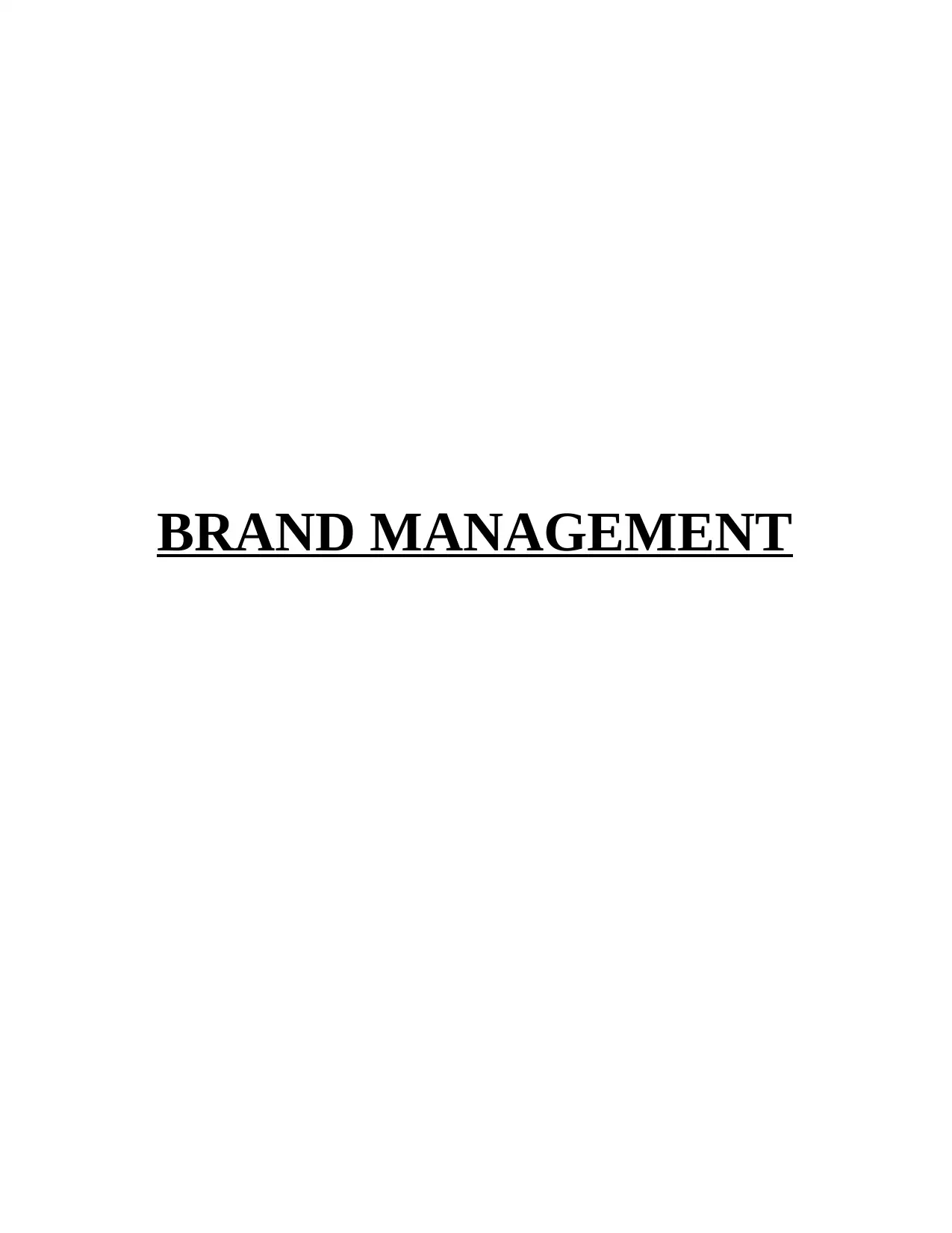
BRAND MANAGEMENT
Secure Best Marks with AI Grader
Need help grading? Try our AI Grader for instant feedback on your assignments.
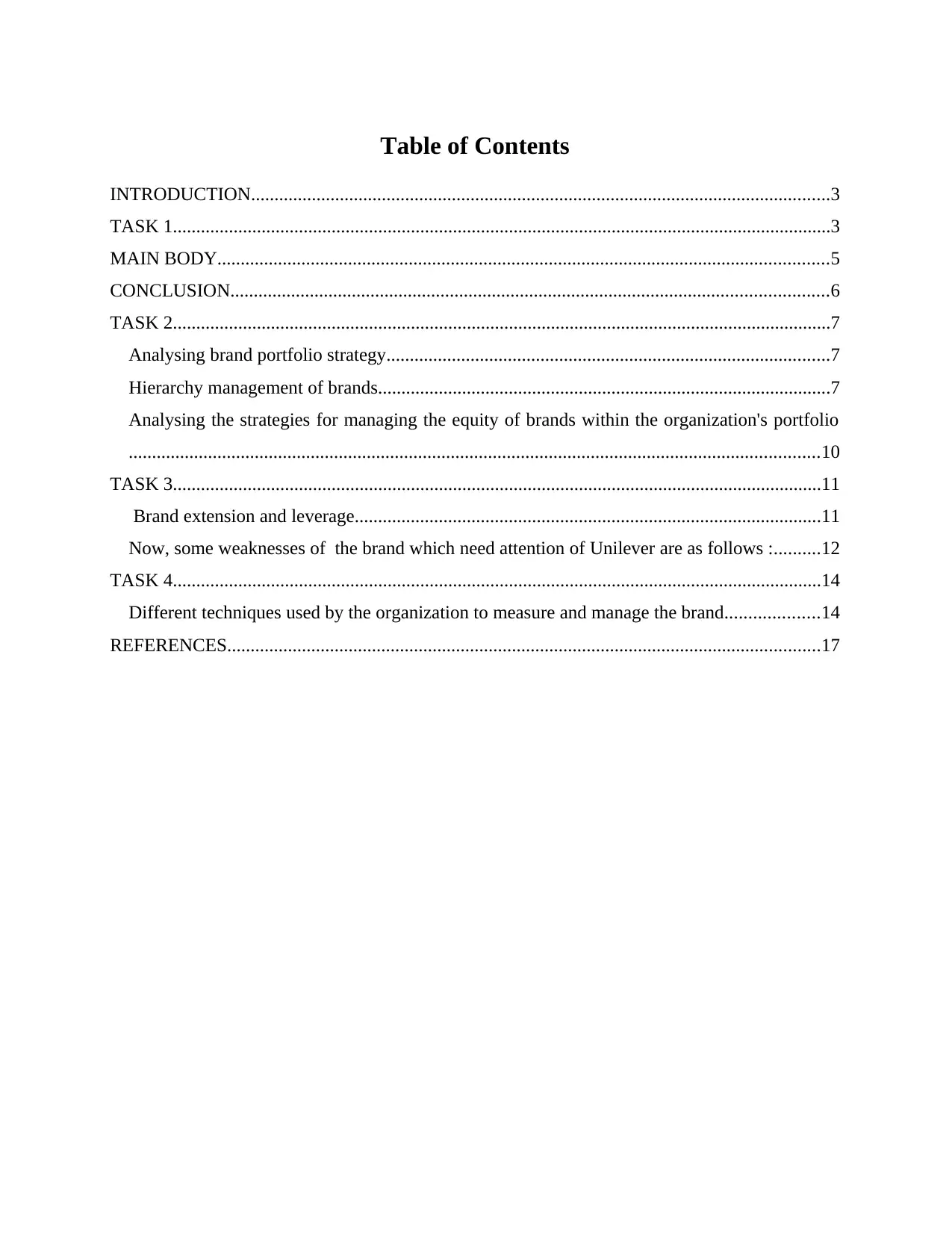
Table of Contents
INTRODUCTION............................................................................................................................3
TASK 1.............................................................................................................................................3
MAIN BODY...................................................................................................................................5
CONCLUSION................................................................................................................................6
TASK 2.............................................................................................................................................7
Analysing brand portfolio strategy...............................................................................................7
Hierarchy management of brands.................................................................................................7
Analysing the strategies for managing the equity of brands within the organization's portfolio
....................................................................................................................................................10
TASK 3...........................................................................................................................................11
Brand extension and leverage....................................................................................................11
Now, some weaknesses of the brand which need attention of Unilever are as follows :..........12
TASK 4...........................................................................................................................................14
Different techniques used by the organization to measure and manage the brand....................14
REFERENCES...............................................................................................................................17
INTRODUCTION............................................................................................................................3
TASK 1.............................................................................................................................................3
MAIN BODY...................................................................................................................................5
CONCLUSION................................................................................................................................6
TASK 2.............................................................................................................................................7
Analysing brand portfolio strategy...............................................................................................7
Hierarchy management of brands.................................................................................................7
Analysing the strategies for managing the equity of brands within the organization's portfolio
....................................................................................................................................................10
TASK 3...........................................................................................................................................11
Brand extension and leverage....................................................................................................11
Now, some weaknesses of the brand which need attention of Unilever are as follows :..........12
TASK 4...........................................................................................................................................14
Different techniques used by the organization to measure and manage the brand....................14
REFERENCES...............................................................................................................................17
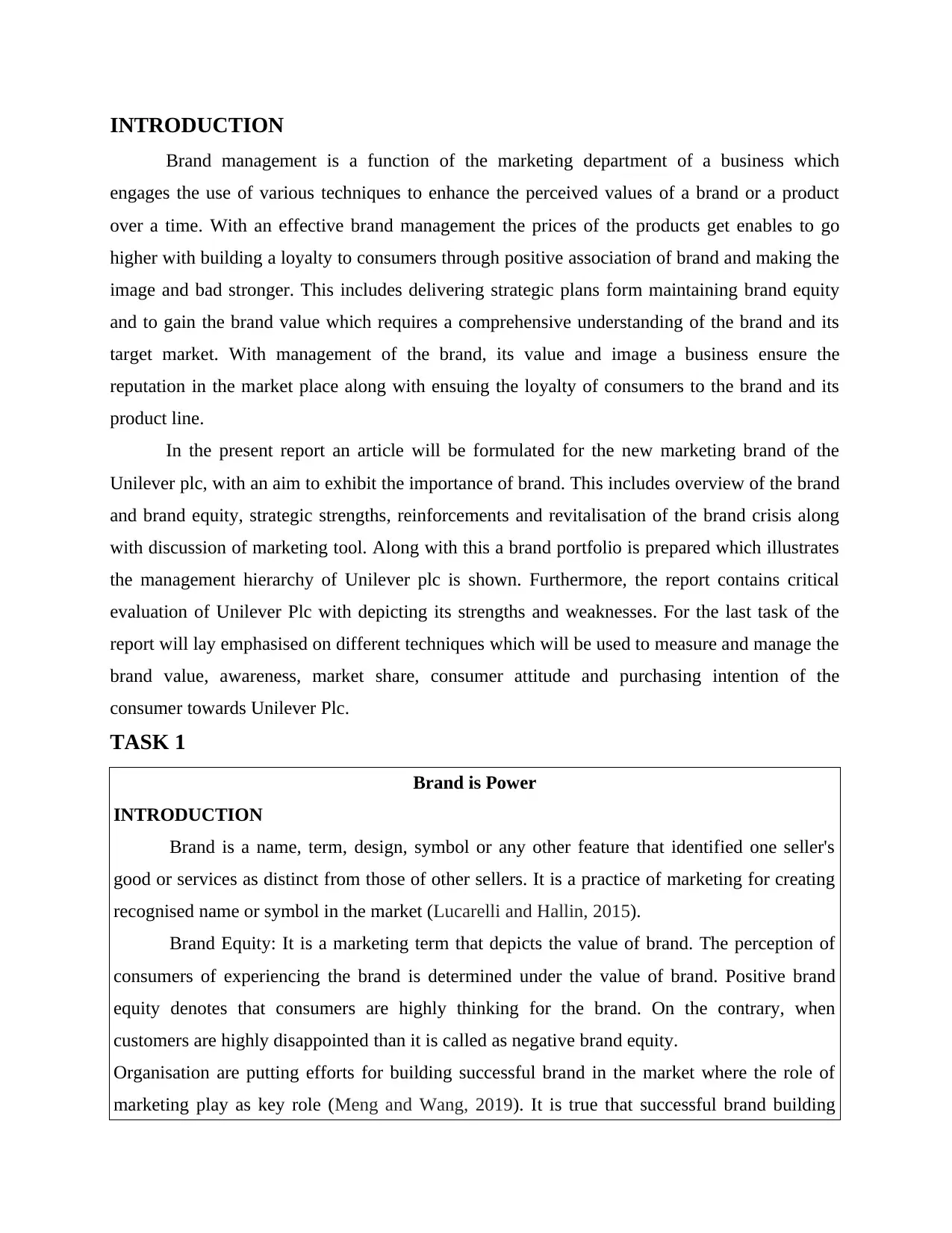
INTRODUCTION
Brand management is a function of the marketing department of a business which
engages the use of various techniques to enhance the perceived values of a brand or a product
over a time. With an effective brand management the prices of the products get enables to go
higher with building a loyalty to consumers through positive association of brand and making the
image and bad stronger. This includes delivering strategic plans form maintaining brand equity
and to gain the brand value which requires a comprehensive understanding of the brand and its
target market. With management of the brand, its value and image a business ensure the
reputation in the market place along with ensuing the loyalty of consumers to the brand and its
product line.
In the present report an article will be formulated for the new marketing brand of the
Unilever plc, with an aim to exhibit the importance of brand. This includes overview of the brand
and brand equity, strategic strengths, reinforcements and revitalisation of the brand crisis along
with discussion of marketing tool. Along with this a brand portfolio is prepared which illustrates
the management hierarchy of Unilever plc is shown. Furthermore, the report contains critical
evaluation of Unilever Plc with depicting its strengths and weaknesses. For the last task of the
report will lay emphasised on different techniques which will be used to measure and manage the
brand value, awareness, market share, consumer attitude and purchasing intention of the
consumer towards Unilever Plc.
TASK 1
Brand is Power
INTRODUCTION
Brand is a name, term, design, symbol or any other feature that identified one seller's
good or services as distinct from those of other sellers. It is a practice of marketing for creating
recognised name or symbol in the market (Lucarelli and Hallin, 2015).
Brand Equity: It is a marketing term that depicts the value of brand. The perception of
consumers of experiencing the brand is determined under the value of brand. Positive brand
equity denotes that consumers are highly thinking for the brand. On the contrary, when
customers are highly disappointed than it is called as negative brand equity.
Organisation are putting efforts for building successful brand in the market where the role of
marketing play as key role (Meng and Wang, 2019). It is true that successful brand building
Brand management is a function of the marketing department of a business which
engages the use of various techniques to enhance the perceived values of a brand or a product
over a time. With an effective brand management the prices of the products get enables to go
higher with building a loyalty to consumers through positive association of brand and making the
image and bad stronger. This includes delivering strategic plans form maintaining brand equity
and to gain the brand value which requires a comprehensive understanding of the brand and its
target market. With management of the brand, its value and image a business ensure the
reputation in the market place along with ensuing the loyalty of consumers to the brand and its
product line.
In the present report an article will be formulated for the new marketing brand of the
Unilever plc, with an aim to exhibit the importance of brand. This includes overview of the brand
and brand equity, strategic strengths, reinforcements and revitalisation of the brand crisis along
with discussion of marketing tool. Along with this a brand portfolio is prepared which illustrates
the management hierarchy of Unilever plc is shown. Furthermore, the report contains critical
evaluation of Unilever Plc with depicting its strengths and weaknesses. For the last task of the
report will lay emphasised on different techniques which will be used to measure and manage the
brand value, awareness, market share, consumer attitude and purchasing intention of the
consumer towards Unilever Plc.
TASK 1
Brand is Power
INTRODUCTION
Brand is a name, term, design, symbol or any other feature that identified one seller's
good or services as distinct from those of other sellers. It is a practice of marketing for creating
recognised name or symbol in the market (Lucarelli and Hallin, 2015).
Brand Equity: It is a marketing term that depicts the value of brand. The perception of
consumers of experiencing the brand is determined under the value of brand. Positive brand
equity denotes that consumers are highly thinking for the brand. On the contrary, when
customers are highly disappointed than it is called as negative brand equity.
Organisation are putting efforts for building successful brand in the market where the role of
marketing play as key role (Meng and Wang, 2019). It is true that successful brand building
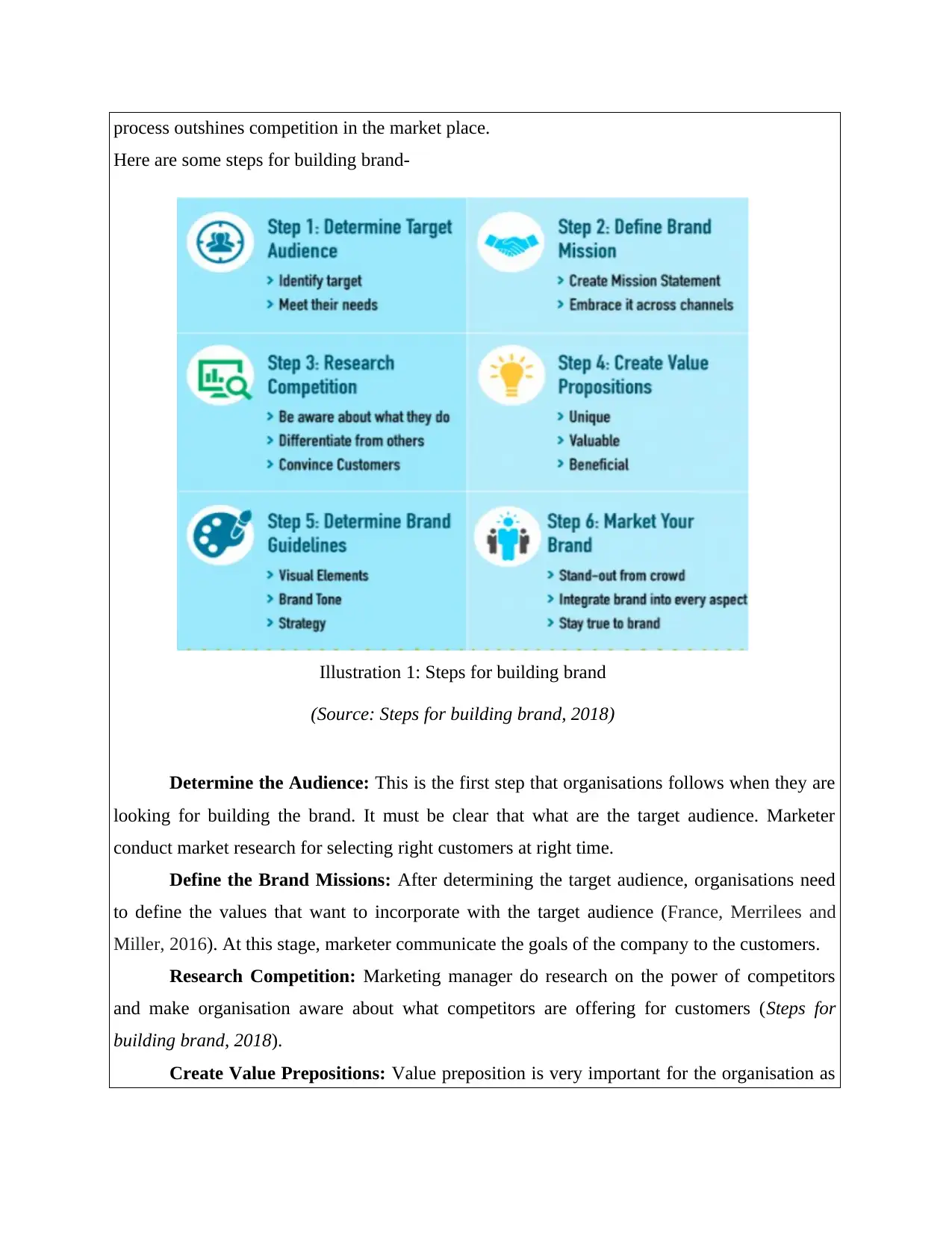
process outshines competition in the market place.
Here are some steps for building brand-
Determine the Audience: This is the first step that organisations follows when they are
looking for building the brand. It must be clear that what are the target audience. Marketer
conduct market research for selecting right customers at right time.
Define the Brand Missions: After determining the target audience, organisations need
to define the values that want to incorporate with the target audience (France, Merrilees and
Miller, 2016). At this stage, marketer communicate the goals of the company to the customers.
Research Competition: Marketing manager do research on the power of competitors
and make organisation aware about what competitors are offering for customers (Steps for
building brand, 2018).
Create Value Prepositions: Value preposition is very important for the organisation as
Illustration 1: Steps for building brand
(Source: Steps for building brand, 2018)
Here are some steps for building brand-
Determine the Audience: This is the first step that organisations follows when they are
looking for building the brand. It must be clear that what are the target audience. Marketer
conduct market research for selecting right customers at right time.
Define the Brand Missions: After determining the target audience, organisations need
to define the values that want to incorporate with the target audience (France, Merrilees and
Miller, 2016). At this stage, marketer communicate the goals of the company to the customers.
Research Competition: Marketing manager do research on the power of competitors
and make organisation aware about what competitors are offering for customers (Steps for
building brand, 2018).
Create Value Prepositions: Value preposition is very important for the organisation as
Illustration 1: Steps for building brand
(Source: Steps for building brand, 2018)
Secure Best Marks with AI Grader
Need help grading? Try our AI Grader for instant feedback on your assignments.
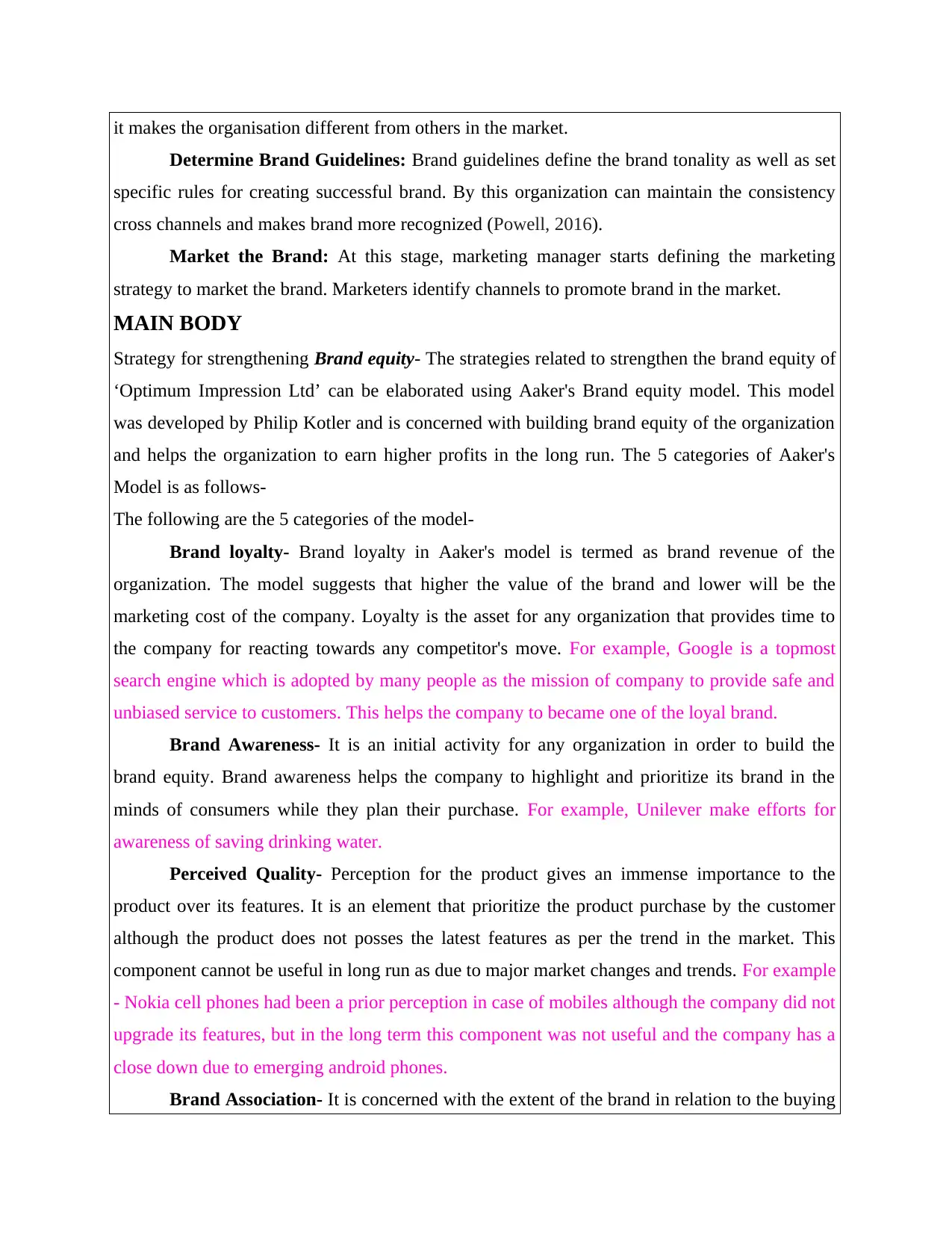
it makes the organisation different from others in the market.
Determine Brand Guidelines: Brand guidelines define the brand tonality as well as set
specific rules for creating successful brand. By this organization can maintain the consistency
cross channels and makes brand more recognized (Powell, 2016).
Market the Brand: At this stage, marketing manager starts defining the marketing
strategy to market the brand. Marketers identify channels to promote brand in the market.
MAIN BODY
Strategy for strengthening Brand equity- The strategies related to strengthen the brand equity of
‘Optimum Impression Ltd’ can be elaborated using Aaker's Brand equity model. This model
was developed by Philip Kotler and is concerned with building brand equity of the organization
and helps the organization to earn higher profits in the long run. The 5 categories of Aaker's
Model is as follows-
The following are the 5 categories of the model-
Brand loyalty- Brand loyalty in Aaker's model is termed as brand revenue of the
organization. The model suggests that higher the value of the brand and lower will be the
marketing cost of the company. Loyalty is the asset for any organization that provides time to
the company for reacting towards any competitor's move. For example, Google is a topmost
search engine which is adopted by many people as the mission of company to provide safe and
unbiased service to customers. This helps the company to became one of the loyal brand.
Brand Awareness- It is an initial activity for any organization in order to build the
brand equity. Brand awareness helps the company to highlight and prioritize its brand in the
minds of consumers while they plan their purchase. For example, Unilever make efforts for
awareness of saving drinking water.
Perceived Quality- Perception for the product gives an immense importance to the
product over its features. It is an element that prioritize the product purchase by the customer
although the product does not posses the latest features as per the trend in the market. This
component cannot be useful in long run as due to major market changes and trends. For example
- Nokia cell phones had been a prior perception in case of mobiles although the company did not
upgrade its features, but in the long term this component was not useful and the company has a
close down due to emerging android phones.
Brand Association- It is concerned with the extent of the brand in relation to the buying
Determine Brand Guidelines: Brand guidelines define the brand tonality as well as set
specific rules for creating successful brand. By this organization can maintain the consistency
cross channels and makes brand more recognized (Powell, 2016).
Market the Brand: At this stage, marketing manager starts defining the marketing
strategy to market the brand. Marketers identify channels to promote brand in the market.
MAIN BODY
Strategy for strengthening Brand equity- The strategies related to strengthen the brand equity of
‘Optimum Impression Ltd’ can be elaborated using Aaker's Brand equity model. This model
was developed by Philip Kotler and is concerned with building brand equity of the organization
and helps the organization to earn higher profits in the long run. The 5 categories of Aaker's
Model is as follows-
The following are the 5 categories of the model-
Brand loyalty- Brand loyalty in Aaker's model is termed as brand revenue of the
organization. The model suggests that higher the value of the brand and lower will be the
marketing cost of the company. Loyalty is the asset for any organization that provides time to
the company for reacting towards any competitor's move. For example, Google is a topmost
search engine which is adopted by many people as the mission of company to provide safe and
unbiased service to customers. This helps the company to became one of the loyal brand.
Brand Awareness- It is an initial activity for any organization in order to build the
brand equity. Brand awareness helps the company to highlight and prioritize its brand in the
minds of consumers while they plan their purchase. For example, Unilever make efforts for
awareness of saving drinking water.
Perceived Quality- Perception for the product gives an immense importance to the
product over its features. It is an element that prioritize the product purchase by the customer
although the product does not posses the latest features as per the trend in the market. This
component cannot be useful in long run as due to major market changes and trends. For example
- Nokia cell phones had been a prior perception in case of mobiles although the company did not
upgrade its features, but in the long term this component was not useful and the company has a
close down due to emerging android phones.
Brand Association- It is concerned with the extent of the brand in relation to the buying

behaviour, positive attitude and differentiation of brand from other companies. It shows how
much weight a brand creates over a consumer buying behaviour and attitude. For example,
Hyatt Hotel is associated with the image of comfort and luxury living.
Other proprietary assets- These are the intangible assets for protection of the property
rights they include- Patents, trademarks, channel relationships etc. Like, The trademark of
Google costs $44.3 billion which differentiated it from other competitors.
BRAND EXTENSION-
Brand extension refers to using an existing brand name for the launch of a new product
in market to make it more popular. It helps in gaining the popularity of the new product to the
extent of the existing brand. For example- Google's primary business is search engine, but it has
attached its name with the new products such as google wallet, google pay, google maps etc.
BRAND REINFORCEMENT AND REVITALIZING BRANDS-
It is a process of maintaining the equity of a brand and keeping the brand alive in the
minds of new as well as existing customers. In simple words there are three stages of the
product brand- Introduction stage, growth stage, maturity stage and decline stage. Brand
revitalization is concerned with monitoring the brand and implementing strategies to keep it
alive before it falls into decline stage of the product life cycle. For example Apple revitalize its
product by continuous innovation of their brand before it reaches to the decline stage and keep
the brand alive. Another example is Product of Pepsi Mountain Dew was launched in 1969 with
attractive Tag line “yahoo mountain dew” which later re positioned after making changes in Tag
line that is 'Do the Dew” by targeting young males to perform adventurous sports.
CONCLUSION
From the above discussion, it has been clearly understood that branding is very
important for the organisation to achieve the competitive position in the market. Today's, it is
very difficult to gain trust of customers but trust is creates with the help of branding. Branding
also improves the identification, remembrance as well as it also supports the efforts of
marketing (Merdin-Uygur Kubat and Gürhan-Canli, 2018). Further, organisation are also highly
concern about marketing because it helps in generating new revenue for the organisation.
Further, it has also been identified that, branding is one of the best tool to raise credibility by
amending the business perception. Thus, branding is one of the best instrument that is used by
much weight a brand creates over a consumer buying behaviour and attitude. For example,
Hyatt Hotel is associated with the image of comfort and luxury living.
Other proprietary assets- These are the intangible assets for protection of the property
rights they include- Patents, trademarks, channel relationships etc. Like, The trademark of
Google costs $44.3 billion which differentiated it from other competitors.
BRAND EXTENSION-
Brand extension refers to using an existing brand name for the launch of a new product
in market to make it more popular. It helps in gaining the popularity of the new product to the
extent of the existing brand. For example- Google's primary business is search engine, but it has
attached its name with the new products such as google wallet, google pay, google maps etc.
BRAND REINFORCEMENT AND REVITALIZING BRANDS-
It is a process of maintaining the equity of a brand and keeping the brand alive in the
minds of new as well as existing customers. In simple words there are three stages of the
product brand- Introduction stage, growth stage, maturity stage and decline stage. Brand
revitalization is concerned with monitoring the brand and implementing strategies to keep it
alive before it falls into decline stage of the product life cycle. For example Apple revitalize its
product by continuous innovation of their brand before it reaches to the decline stage and keep
the brand alive. Another example is Product of Pepsi Mountain Dew was launched in 1969 with
attractive Tag line “yahoo mountain dew” which later re positioned after making changes in Tag
line that is 'Do the Dew” by targeting young males to perform adventurous sports.
CONCLUSION
From the above discussion, it has been clearly understood that branding is very
important for the organisation to achieve the competitive position in the market. Today's, it is
very difficult to gain trust of customers but trust is creates with the help of branding. Branding
also improves the identification, remembrance as well as it also supports the efforts of
marketing (Merdin-Uygur Kubat and Gürhan-Canli, 2018). Further, organisation are also highly
concern about marketing because it helps in generating new revenue for the organisation.
Further, it has also been identified that, branding is one of the best tool to raise credibility by
amending the business perception. Thus, branding is one of the best instrument that is used by
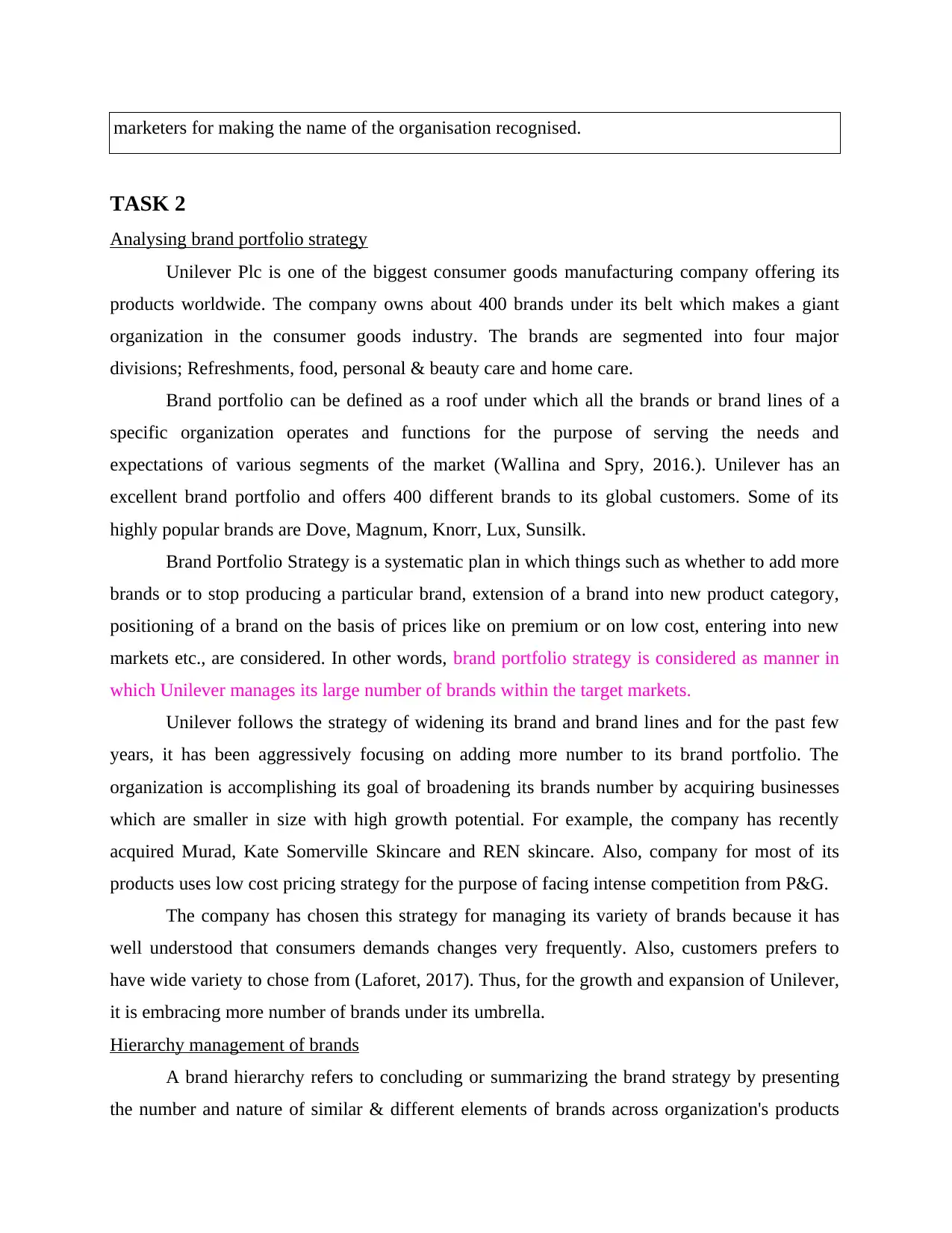
marketers for making the name of the organisation recognised.
TASK 2
Analysing brand portfolio strategy
Unilever Plc is one of the biggest consumer goods manufacturing company offering its
products worldwide. The company owns about 400 brands under its belt which makes a giant
organization in the consumer goods industry. The brands are segmented into four major
divisions; Refreshments, food, personal & beauty care and home care.
Brand portfolio can be defined as a roof under which all the brands or brand lines of a
specific organization operates and functions for the purpose of serving the needs and
expectations of various segments of the market (Wallina and Spry, 2016.). Unilever has an
excellent brand portfolio and offers 400 different brands to its global customers. Some of its
highly popular brands are Dove, Magnum, Knorr, Lux, Sunsilk.
Brand Portfolio Strategy is a systematic plan in which things such as whether to add more
brands or to stop producing a particular brand, extension of a brand into new product category,
positioning of a brand on the basis of prices like on premium or on low cost, entering into new
markets etc., are considered. In other words, brand portfolio strategy is considered as manner in
which Unilever manages its large number of brands within the target markets.
Unilever follows the strategy of widening its brand and brand lines and for the past few
years, it has been aggressively focusing on adding more number to its brand portfolio. The
organization is accomplishing its goal of broadening its brands number by acquiring businesses
which are smaller in size with high growth potential. For example, the company has recently
acquired Murad, Kate Somerville Skincare and REN skincare. Also, company for most of its
products uses low cost pricing strategy for the purpose of facing intense competition from P&G.
The company has chosen this strategy for managing its variety of brands because it has
well understood that consumers demands changes very frequently. Also, customers prefers to
have wide variety to chose from (Laforet, 2017). Thus, for the growth and expansion of Unilever,
it is embracing more number of brands under its umbrella.
Hierarchy management of brands
A brand hierarchy refers to concluding or summarizing the brand strategy by presenting
the number and nature of similar & different elements of brands across organization's products
TASK 2
Analysing brand portfolio strategy
Unilever Plc is one of the biggest consumer goods manufacturing company offering its
products worldwide. The company owns about 400 brands under its belt which makes a giant
organization in the consumer goods industry. The brands are segmented into four major
divisions; Refreshments, food, personal & beauty care and home care.
Brand portfolio can be defined as a roof under which all the brands or brand lines of a
specific organization operates and functions for the purpose of serving the needs and
expectations of various segments of the market (Wallina and Spry, 2016.). Unilever has an
excellent brand portfolio and offers 400 different brands to its global customers. Some of its
highly popular brands are Dove, Magnum, Knorr, Lux, Sunsilk.
Brand Portfolio Strategy is a systematic plan in which things such as whether to add more
brands or to stop producing a particular brand, extension of a brand into new product category,
positioning of a brand on the basis of prices like on premium or on low cost, entering into new
markets etc., are considered. In other words, brand portfolio strategy is considered as manner in
which Unilever manages its large number of brands within the target markets.
Unilever follows the strategy of widening its brand and brand lines and for the past few
years, it has been aggressively focusing on adding more number to its brand portfolio. The
organization is accomplishing its goal of broadening its brands number by acquiring businesses
which are smaller in size with high growth potential. For example, the company has recently
acquired Murad, Kate Somerville Skincare and REN skincare. Also, company for most of its
products uses low cost pricing strategy for the purpose of facing intense competition from P&G.
The company has chosen this strategy for managing its variety of brands because it has
well understood that consumers demands changes very frequently. Also, customers prefers to
have wide variety to chose from (Laforet, 2017). Thus, for the growth and expansion of Unilever,
it is embracing more number of brands under its umbrella.
Hierarchy management of brands
A brand hierarchy refers to concluding or summarizing the brand strategy by presenting
the number and nature of similar & different elements of brands across organization's products
Paraphrase This Document
Need a fresh take? Get an instant paraphrase of this document with our AI Paraphraser
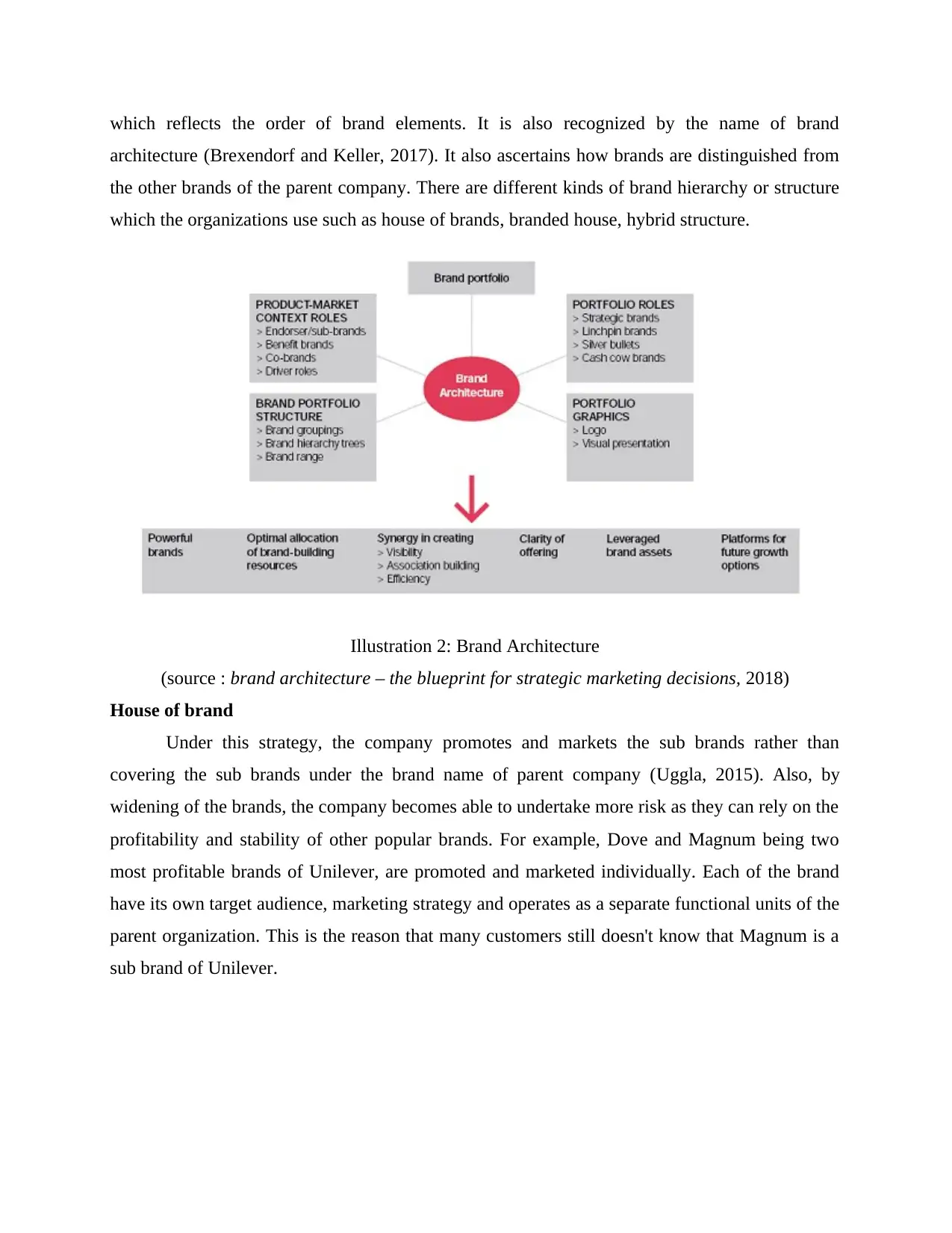
which reflects the order of brand elements. It is also recognized by the name of brand
architecture (Brexendorf and Keller, 2017). It also ascertains how brands are distinguished from
the other brands of the parent company. There are different kinds of brand hierarchy or structure
which the organizations use such as house of brands, branded house, hybrid structure.
Illustration 2: Brand Architecture
(source : brand architecture – the blueprint for strategic marketing decisions, 2018)
House of brand
Under this strategy, the company promotes and markets the sub brands rather than
covering the sub brands under the brand name of parent company (Uggla, 2015). Also, by
widening of the brands, the company becomes able to undertake more risk as they can rely on the
profitability and stability of other popular brands. For example, Dove and Magnum being two
most profitable brands of Unilever, are promoted and marketed individually. Each of the brand
have its own target audience, marketing strategy and operates as a separate functional units of the
parent organization. This is the reason that many customers still doesn't know that Magnum is a
sub brand of Unilever.
architecture (Brexendorf and Keller, 2017). It also ascertains how brands are distinguished from
the other brands of the parent company. There are different kinds of brand hierarchy or structure
which the organizations use such as house of brands, branded house, hybrid structure.
Illustration 2: Brand Architecture
(source : brand architecture – the blueprint for strategic marketing decisions, 2018)
House of brand
Under this strategy, the company promotes and markets the sub brands rather than
covering the sub brands under the brand name of parent company (Uggla, 2015). Also, by
widening of the brands, the company becomes able to undertake more risk as they can rely on the
profitability and stability of other popular brands. For example, Dove and Magnum being two
most profitable brands of Unilever, are promoted and marketed individually. Each of the brand
have its own target audience, marketing strategy and operates as a separate functional units of the
parent organization. This is the reason that many customers still doesn't know that Magnum is a
sub brand of Unilever.
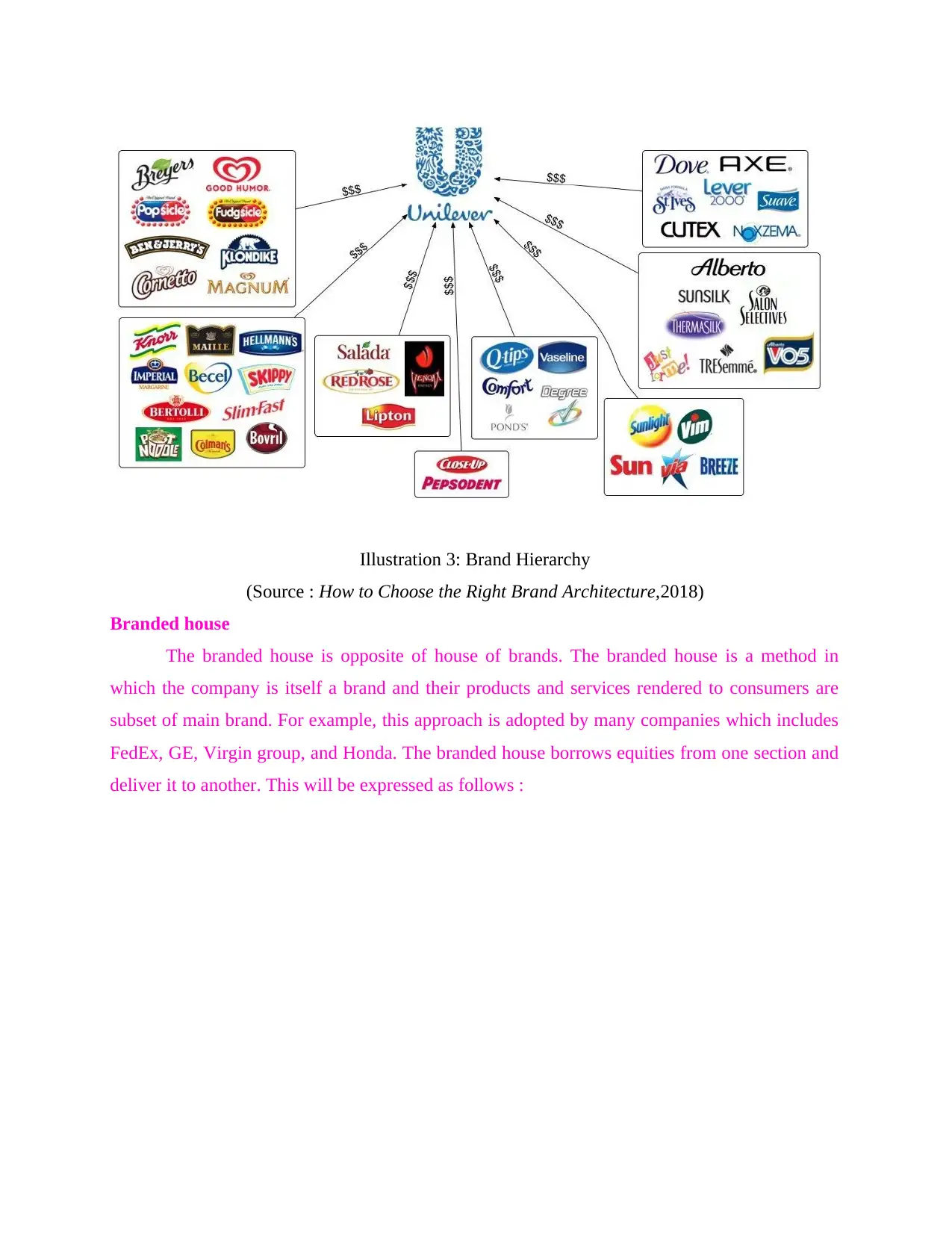
Illustration 3: Brand Hierarchy
(Source : How to Choose the Right Brand Architecture,2018)
Branded house
The branded house is opposite of house of brands. The branded house is a method in
which the company is itself a brand and their products and services rendered to consumers are
subset of main brand. For example, this approach is adopted by many companies which includes
FedEx, GE, Virgin group, and Honda. The branded house borrows equities from one section and
deliver it to another. This will be expressed as follows :
(Source : How to Choose the Right Brand Architecture,2018)
Branded house
The branded house is opposite of house of brands. The branded house is a method in
which the company is itself a brand and their products and services rendered to consumers are
subset of main brand. For example, this approach is adopted by many companies which includes
FedEx, GE, Virgin group, and Honda. The branded house borrows equities from one section and
deliver it to another. This will be expressed as follows :
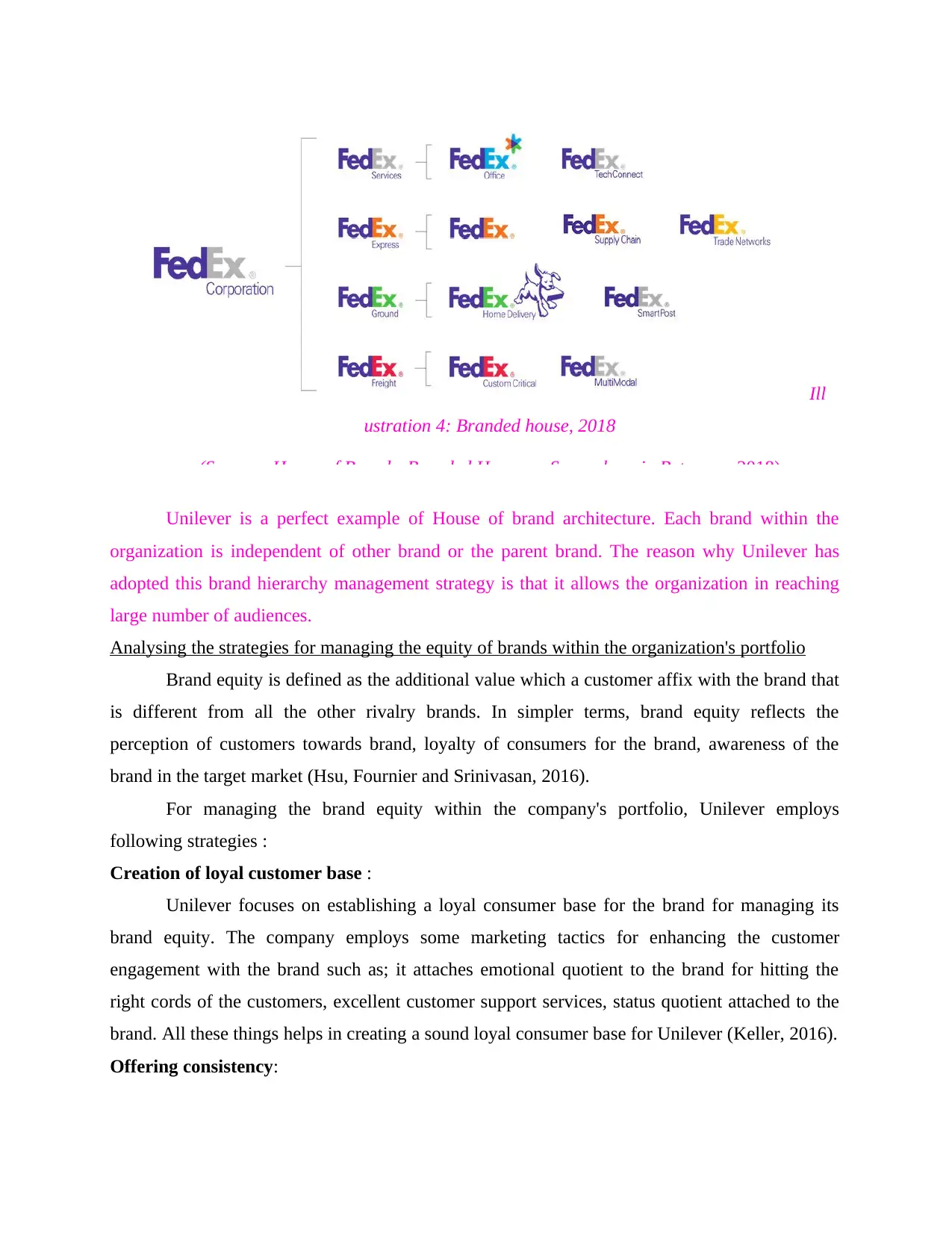
Unilever is a perfect example of House of brand architecture. Each brand within the
organization is independent of other brand or the parent brand. The reason why Unilever has
adopted this brand hierarchy management strategy is that it allows the organization in reaching
large number of audiences.
Analysing the strategies for managing the equity of brands within the organization's portfolio
Brand equity is defined as the additional value which a customer affix with the brand that
is different from all the other rivalry brands. In simpler terms, brand equity reflects the
perception of customers towards brand, loyalty of consumers for the brand, awareness of the
brand in the target market (Hsu, Fournier and Srinivasan, 2016).
For managing the brand equity within the company's portfolio, Unilever employs
following strategies :
Creation of loyal customer base :
Unilever focuses on establishing a loyal consumer base for the brand for managing its
brand equity. The company employs some marketing tactics for enhancing the customer
engagement with the brand such as; it attaches emotional quotient to the brand for hitting the
right cords of the customers, excellent customer support services, status quotient attached to the
brand. All these things helps in creating a sound loyal consumer base for Unilever (Keller, 2016).
Offering consistency:
Ill
ustration 4: Branded house, 2018
(Source : House of Brands, Branded House or Somewhere in Between, 2018)
organization is independent of other brand or the parent brand. The reason why Unilever has
adopted this brand hierarchy management strategy is that it allows the organization in reaching
large number of audiences.
Analysing the strategies for managing the equity of brands within the organization's portfolio
Brand equity is defined as the additional value which a customer affix with the brand that
is different from all the other rivalry brands. In simpler terms, brand equity reflects the
perception of customers towards brand, loyalty of consumers for the brand, awareness of the
brand in the target market (Hsu, Fournier and Srinivasan, 2016).
For managing the brand equity within the company's portfolio, Unilever employs
following strategies :
Creation of loyal customer base :
Unilever focuses on establishing a loyal consumer base for the brand for managing its
brand equity. The company employs some marketing tactics for enhancing the customer
engagement with the brand such as; it attaches emotional quotient to the brand for hitting the
right cords of the customers, excellent customer support services, status quotient attached to the
brand. All these things helps in creating a sound loyal consumer base for Unilever (Keller, 2016).
Offering consistency:
Ill
ustration 4: Branded house, 2018
(Source : House of Brands, Branded House or Somewhere in Between, 2018)
Secure Best Marks with AI Grader
Need help grading? Try our AI Grader for instant feedback on your assignments.
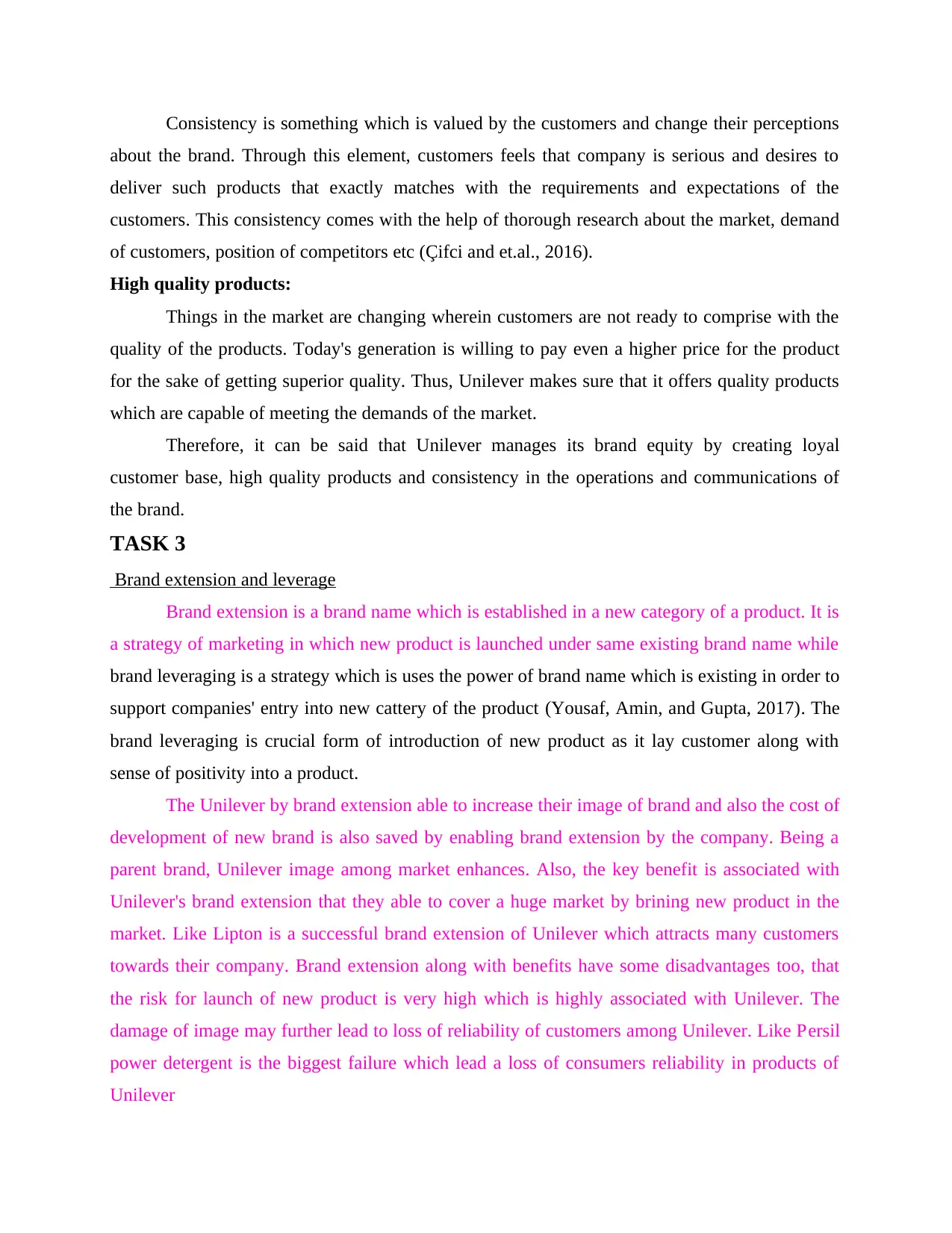
Consistency is something which is valued by the customers and change their perceptions
about the brand. Through this element, customers feels that company is serious and desires to
deliver such products that exactly matches with the requirements and expectations of the
customers. This consistency comes with the help of thorough research about the market, demand
of customers, position of competitors etc (Çifci and et.al., 2016).
High quality products:
Things in the market are changing wherein customers are not ready to comprise with the
quality of the products. Today's generation is willing to pay even a higher price for the product
for the sake of getting superior quality. Thus, Unilever makes sure that it offers quality products
which are capable of meeting the demands of the market.
Therefore, it can be said that Unilever manages its brand equity by creating loyal
customer base, high quality products and consistency in the operations and communications of
the brand.
TASK 3
Brand extension and leverage
Brand extension is a brand name which is established in a new category of a product. It is
a strategy of marketing in which new product is launched under same existing brand name while
brand leveraging is a strategy which is uses the power of brand name which is existing in order to
support companies' entry into new cattery of the product (Yousaf, Amin, and Gupta, 2017). The
brand leveraging is crucial form of introduction of new product as it lay customer along with
sense of positivity into a product.
The Unilever by brand extension able to increase their image of brand and also the cost of
development of new brand is also saved by enabling brand extension by the company. Being a
parent brand, Unilever image among market enhances. Also, the key benefit is associated with
Unilever's brand extension that they able to cover a huge market by brining new product in the
market. Like Lipton is a successful brand extension of Unilever which attracts many customers
towards their company. Brand extension along with benefits have some disadvantages too, that
the risk for launch of new product is very high which is highly associated with Unilever. The
damage of image may further lead to loss of reliability of customers among Unilever. Like Persil
power detergent is the biggest failure which lead a loss of consumers reliability in products of
Unilever
about the brand. Through this element, customers feels that company is serious and desires to
deliver such products that exactly matches with the requirements and expectations of the
customers. This consistency comes with the help of thorough research about the market, demand
of customers, position of competitors etc (Çifci and et.al., 2016).
High quality products:
Things in the market are changing wherein customers are not ready to comprise with the
quality of the products. Today's generation is willing to pay even a higher price for the product
for the sake of getting superior quality. Thus, Unilever makes sure that it offers quality products
which are capable of meeting the demands of the market.
Therefore, it can be said that Unilever manages its brand equity by creating loyal
customer base, high quality products and consistency in the operations and communications of
the brand.
TASK 3
Brand extension and leverage
Brand extension is a brand name which is established in a new category of a product. It is
a strategy of marketing in which new product is launched under same existing brand name while
brand leveraging is a strategy which is uses the power of brand name which is existing in order to
support companies' entry into new cattery of the product (Yousaf, Amin, and Gupta, 2017). The
brand leveraging is crucial form of introduction of new product as it lay customer along with
sense of positivity into a product.
The Unilever by brand extension able to increase their image of brand and also the cost of
development of new brand is also saved by enabling brand extension by the company. Being a
parent brand, Unilever image among market enhances. Also, the key benefit is associated with
Unilever's brand extension that they able to cover a huge market by brining new product in the
market. Like Lipton is a successful brand extension of Unilever which attracts many customers
towards their company. Brand extension along with benefits have some disadvantages too, that
the risk for launch of new product is very high which is highly associated with Unilever. The
damage of image may further lead to loss of reliability of customers among Unilever. Like Persil
power detergent is the biggest failure which lead a loss of consumers reliability in products of
Unilever
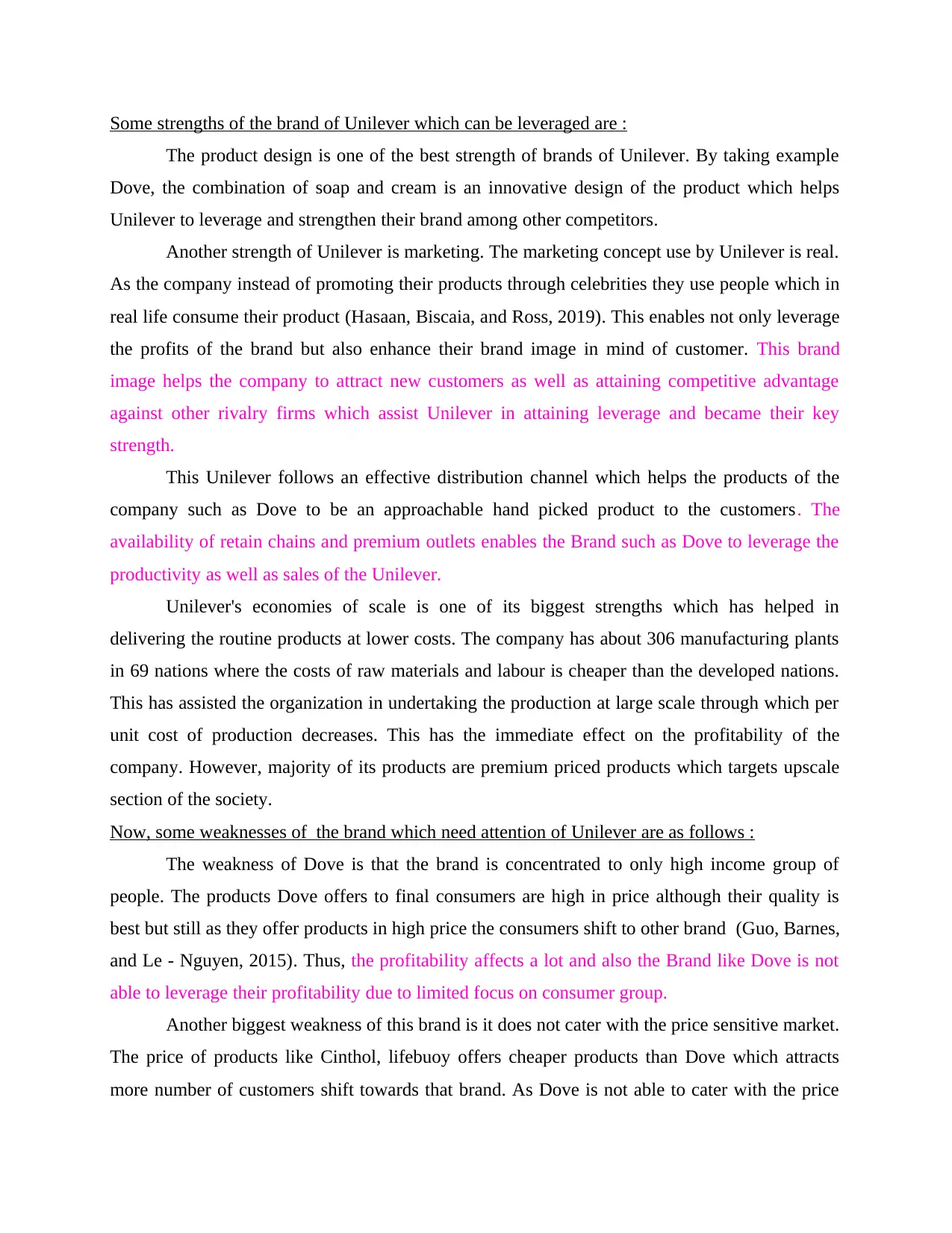
Some strengths of the brand of Unilever which can be leveraged are :
The product design is one of the best strength of brands of Unilever. By taking example
Dove, the combination of soap and cream is an innovative design of the product which helps
Unilever to leverage and strengthen their brand among other competitors.
Another strength of Unilever is marketing. The marketing concept use by Unilever is real.
As the company instead of promoting their products through celebrities they use people which in
real life consume their product (Hasaan, Biscaia, and Ross, 2019). This enables not only leverage
the profits of the brand but also enhance their brand image in mind of customer. This brand
image helps the company to attract new customers as well as attaining competitive advantage
against other rivalry firms which assist Unilever in attaining leverage and became their key
strength.
This Unilever follows an effective distribution channel which helps the products of the
company such as Dove to be an approachable hand picked product to the customers. The
availability of retain chains and premium outlets enables the Brand such as Dove to leverage the
productivity as well as sales of the Unilever.
Unilever's economies of scale is one of its biggest strengths which has helped in
delivering the routine products at lower costs. The company has about 306 manufacturing plants
in 69 nations where the costs of raw materials and labour is cheaper than the developed nations.
This has assisted the organization in undertaking the production at large scale through which per
unit cost of production decreases. This has the immediate effect on the profitability of the
company. However, majority of its products are premium priced products which targets upscale
section of the society.
Now, some weaknesses of the brand which need attention of Unilever are as follows :
The weakness of Dove is that the brand is concentrated to only high income group of
people. The products Dove offers to final consumers are high in price although their quality is
best but still as they offer products in high price the consumers shift to other brand (Guo, Barnes,
and Le - Nguyen, 2015). Thus, the profitability affects a lot and also the Brand like Dove is not
able to leverage their profitability due to limited focus on consumer group.
Another biggest weakness of this brand is it does not cater with the price sensitive market.
The price of products like Cinthol, lifebuoy offers cheaper products than Dove which attracts
more number of customers shift towards that brand. As Dove is not able to cater with the price
The product design is one of the best strength of brands of Unilever. By taking example
Dove, the combination of soap and cream is an innovative design of the product which helps
Unilever to leverage and strengthen their brand among other competitors.
Another strength of Unilever is marketing. The marketing concept use by Unilever is real.
As the company instead of promoting their products through celebrities they use people which in
real life consume their product (Hasaan, Biscaia, and Ross, 2019). This enables not only leverage
the profits of the brand but also enhance their brand image in mind of customer. This brand
image helps the company to attract new customers as well as attaining competitive advantage
against other rivalry firms which assist Unilever in attaining leverage and became their key
strength.
This Unilever follows an effective distribution channel which helps the products of the
company such as Dove to be an approachable hand picked product to the customers. The
availability of retain chains and premium outlets enables the Brand such as Dove to leverage the
productivity as well as sales of the Unilever.
Unilever's economies of scale is one of its biggest strengths which has helped in
delivering the routine products at lower costs. The company has about 306 manufacturing plants
in 69 nations where the costs of raw materials and labour is cheaper than the developed nations.
This has assisted the organization in undertaking the production at large scale through which per
unit cost of production decreases. This has the immediate effect on the profitability of the
company. However, majority of its products are premium priced products which targets upscale
section of the society.
Now, some weaknesses of the brand which need attention of Unilever are as follows :
The weakness of Dove is that the brand is concentrated to only high income group of
people. The products Dove offers to final consumers are high in price although their quality is
best but still as they offer products in high price the consumers shift to other brand (Guo, Barnes,
and Le - Nguyen, 2015). Thus, the profitability affects a lot and also the Brand like Dove is not
able to leverage their profitability due to limited focus on consumer group.
Another biggest weakness of this brand is it does not cater with the price sensitive market.
The price of products like Cinthol, lifebuoy offers cheaper products than Dove which attracts
more number of customers shift towards that brand. As Dove is not able to cater with the price
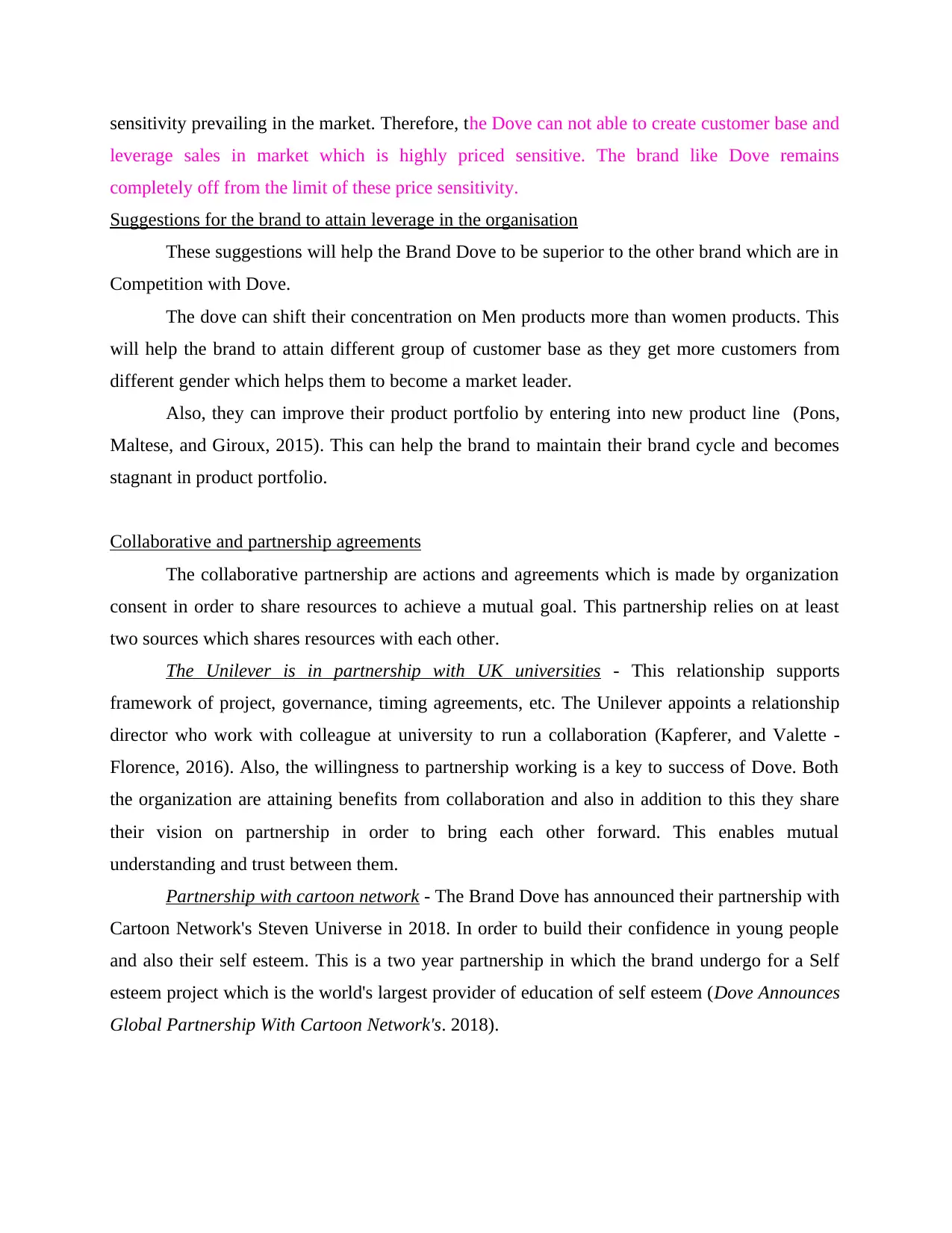
sensitivity prevailing in the market. Therefore, the Dove can not able to create customer base and
leverage sales in market which is highly priced sensitive. The brand like Dove remains
completely off from the limit of these price sensitivity.
Suggestions for the brand to attain leverage in the organisation
These suggestions will help the Brand Dove to be superior to the other brand which are in
Competition with Dove.
The dove can shift their concentration on Men products more than women products. This
will help the brand to attain different group of customer base as they get more customers from
different gender which helps them to become a market leader.
Also, they can improve their product portfolio by entering into new product line (Pons,
Maltese, and Giroux, 2015). This can help the brand to maintain their brand cycle and becomes
stagnant in product portfolio.
Collaborative and partnership agreements
The collaborative partnership are actions and agreements which is made by organization
consent in order to share resources to achieve a mutual goal. This partnership relies on at least
two sources which shares resources with each other.
The Unilever is in partnership with UK universities - This relationship supports
framework of project, governance, timing agreements, etc. The Unilever appoints a relationship
director who work with colleague at university to run a collaboration (Kapferer, and Valette -
Florence, 2016). Also, the willingness to partnership working is a key to success of Dove. Both
the organization are attaining benefits from collaboration and also in addition to this they share
their vision on partnership in order to bring each other forward. This enables mutual
understanding and trust between them.
Partnership with cartoon network - The Brand Dove has announced their partnership with
Cartoon Network's Steven Universe in 2018. In order to build their confidence in young people
and also their self esteem. This is a two year partnership in which the brand undergo for a Self
esteem project which is the world's largest provider of education of self esteem (Dove Announces
Global Partnership With Cartoon Network's. 2018).
leverage sales in market which is highly priced sensitive. The brand like Dove remains
completely off from the limit of these price sensitivity.
Suggestions for the brand to attain leverage in the organisation
These suggestions will help the Brand Dove to be superior to the other brand which are in
Competition with Dove.
The dove can shift their concentration on Men products more than women products. This
will help the brand to attain different group of customer base as they get more customers from
different gender which helps them to become a market leader.
Also, they can improve their product portfolio by entering into new product line (Pons,
Maltese, and Giroux, 2015). This can help the brand to maintain their brand cycle and becomes
stagnant in product portfolio.
Collaborative and partnership agreements
The collaborative partnership are actions and agreements which is made by organization
consent in order to share resources to achieve a mutual goal. This partnership relies on at least
two sources which shares resources with each other.
The Unilever is in partnership with UK universities - This relationship supports
framework of project, governance, timing agreements, etc. The Unilever appoints a relationship
director who work with colleague at university to run a collaboration (Kapferer, and Valette -
Florence, 2016). Also, the willingness to partnership working is a key to success of Dove. Both
the organization are attaining benefits from collaboration and also in addition to this they share
their vision on partnership in order to bring each other forward. This enables mutual
understanding and trust between them.
Partnership with cartoon network - The Brand Dove has announced their partnership with
Cartoon Network's Steven Universe in 2018. In order to build their confidence in young people
and also their self esteem. This is a two year partnership in which the brand undergo for a Self
esteem project which is the world's largest provider of education of self esteem (Dove Announces
Global Partnership With Cartoon Network's. 2018).
Paraphrase This Document
Need a fresh take? Get an instant paraphrase of this document with our AI Paraphraser
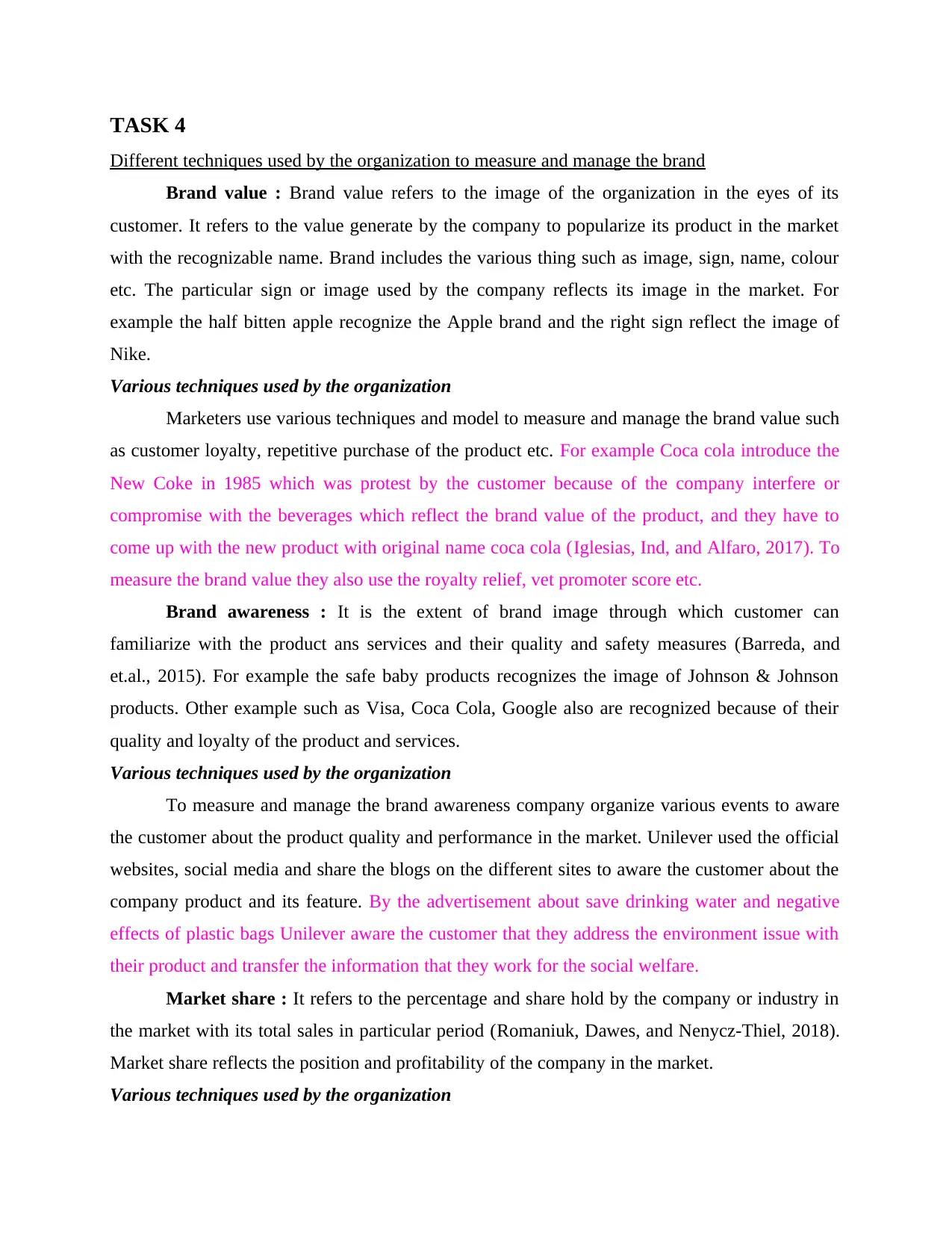
TASK 4
Different techniques used by the organization to measure and manage the brand
Brand value : Brand value refers to the image of the organization in the eyes of its
customer. It refers to the value generate by the company to popularize its product in the market
with the recognizable name. Brand includes the various thing such as image, sign, name, colour
etc. The particular sign or image used by the company reflects its image in the market. For
example the half bitten apple recognize the Apple brand and the right sign reflect the image of
Nike.
Various techniques used by the organization
Marketers use various techniques and model to measure and manage the brand value such
as customer loyalty, repetitive purchase of the product etc. For example Coca cola introduce the
New Coke in 1985 which was protest by the customer because of the company interfere or
compromise with the beverages which reflect the brand value of the product, and they have to
come up with the new product with original name coca cola (Iglesias, Ind, and Alfaro, 2017). To
measure the brand value they also use the royalty relief, vet promoter score etc.
Brand awareness : It is the extent of brand image through which customer can
familiarize with the product ans services and their quality and safety measures (Barreda, and
et.al., 2015). For example the safe baby products recognizes the image of Johnson & Johnson
products. Other example such as Visa, Coca Cola, Google also are recognized because of their
quality and loyalty of the product and services.
Various techniques used by the organization
To measure and manage the brand awareness company organize various events to aware
the customer about the product quality and performance in the market. Unilever used the official
websites, social media and share the blogs on the different sites to aware the customer about the
company product and its feature. By the advertisement about save drinking water and negative
effects of plastic bags Unilever aware the customer that they address the environment issue with
their product and transfer the information that they work for the social welfare.
Market share : It refers to the percentage and share hold by the company or industry in
the market with its total sales in particular period (Romaniuk, Dawes, and Nenycz-Thiel, 2018).
Market share reflects the position and profitability of the company in the market.
Various techniques used by the organization
Different techniques used by the organization to measure and manage the brand
Brand value : Brand value refers to the image of the organization in the eyes of its
customer. It refers to the value generate by the company to popularize its product in the market
with the recognizable name. Brand includes the various thing such as image, sign, name, colour
etc. The particular sign or image used by the company reflects its image in the market. For
example the half bitten apple recognize the Apple brand and the right sign reflect the image of
Nike.
Various techniques used by the organization
Marketers use various techniques and model to measure and manage the brand value such
as customer loyalty, repetitive purchase of the product etc. For example Coca cola introduce the
New Coke in 1985 which was protest by the customer because of the company interfere or
compromise with the beverages which reflect the brand value of the product, and they have to
come up with the new product with original name coca cola (Iglesias, Ind, and Alfaro, 2017). To
measure the brand value they also use the royalty relief, vet promoter score etc.
Brand awareness : It is the extent of brand image through which customer can
familiarize with the product ans services and their quality and safety measures (Barreda, and
et.al., 2015). For example the safe baby products recognizes the image of Johnson & Johnson
products. Other example such as Visa, Coca Cola, Google also are recognized because of their
quality and loyalty of the product and services.
Various techniques used by the organization
To measure and manage the brand awareness company organize various events to aware
the customer about the product quality and performance in the market. Unilever used the official
websites, social media and share the blogs on the different sites to aware the customer about the
company product and its feature. By the advertisement about save drinking water and negative
effects of plastic bags Unilever aware the customer that they address the environment issue with
their product and transfer the information that they work for the social welfare.
Market share : It refers to the percentage and share hold by the company or industry in
the market with its total sales in particular period (Romaniuk, Dawes, and Nenycz-Thiel, 2018).
Market share reflects the position and profitability of the company in the market.
Various techniques used by the organization
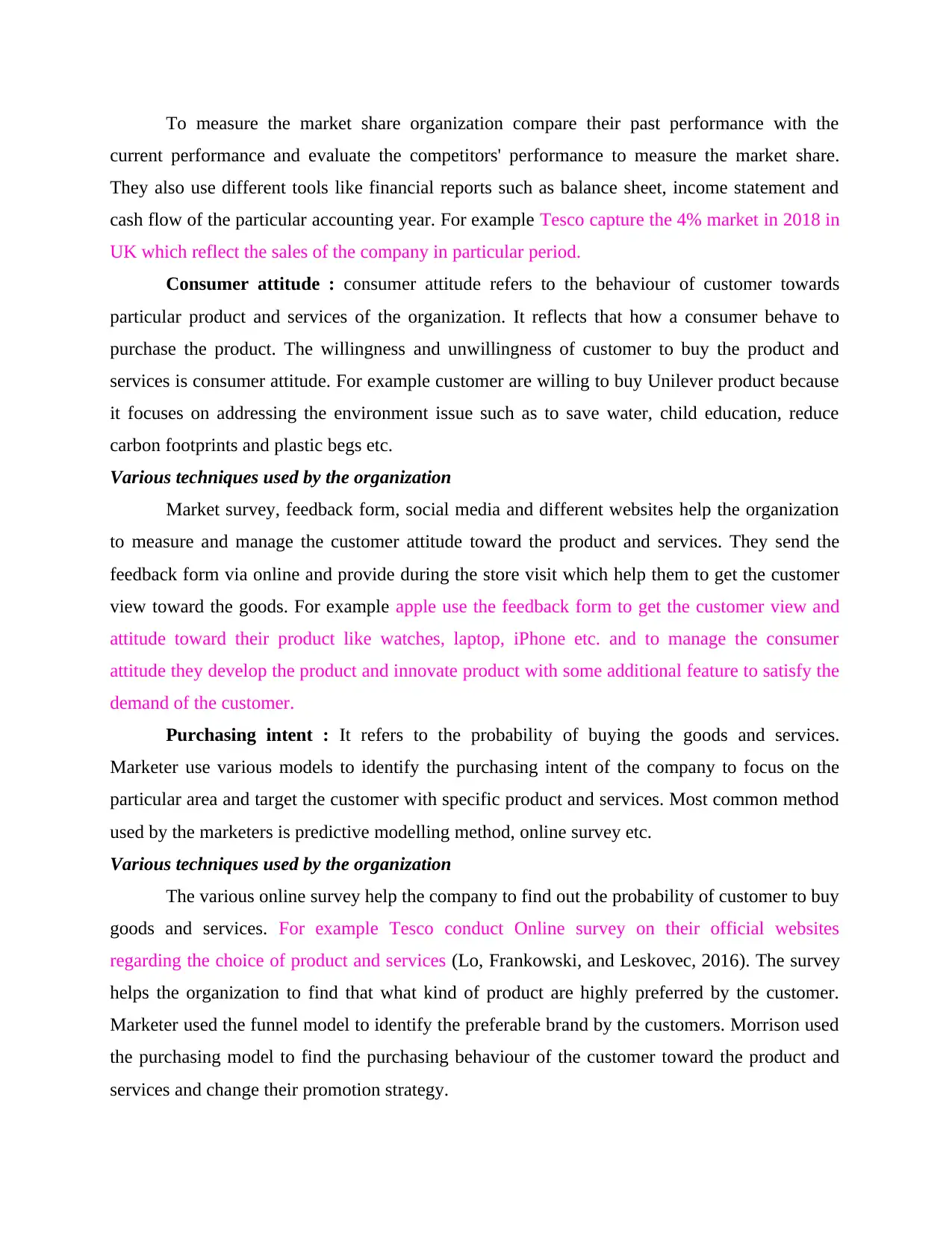
To measure the market share organization compare their past performance with the
current performance and evaluate the competitors' performance to measure the market share.
They also use different tools like financial reports such as balance sheet, income statement and
cash flow of the particular accounting year. For example Tesco capture the 4% market in 2018 in
UK which reflect the sales of the company in particular period.
Consumer attitude : consumer attitude refers to the behaviour of customer towards
particular product and services of the organization. It reflects that how a consumer behave to
purchase the product. The willingness and unwillingness of customer to buy the product and
services is consumer attitude. For example customer are willing to buy Unilever product because
it focuses on addressing the environment issue such as to save water, child education, reduce
carbon footprints and plastic begs etc.
Various techniques used by the organization
Market survey, feedback form, social media and different websites help the organization
to measure and manage the customer attitude toward the product and services. They send the
feedback form via online and provide during the store visit which help them to get the customer
view toward the goods. For example apple use the feedback form to get the customer view and
attitude toward their product like watches, laptop, iPhone etc. and to manage the consumer
attitude they develop the product and innovate product with some additional feature to satisfy the
demand of the customer.
Purchasing intent : It refers to the probability of buying the goods and services.
Marketer use various models to identify the purchasing intent of the company to focus on the
particular area and target the customer with specific product and services. Most common method
used by the marketers is predictive modelling method, online survey etc.
Various techniques used by the organization
The various online survey help the company to find out the probability of customer to buy
goods and services. For example Tesco conduct Online survey on their official websites
regarding the choice of product and services (Lo, Frankowski, and Leskovec, 2016). The survey
helps the organization to find that what kind of product are highly preferred by the customer.
Marketer used the funnel model to identify the preferable brand by the customers. Morrison used
the purchasing model to find the purchasing behaviour of the customer toward the product and
services and change their promotion strategy.
current performance and evaluate the competitors' performance to measure the market share.
They also use different tools like financial reports such as balance sheet, income statement and
cash flow of the particular accounting year. For example Tesco capture the 4% market in 2018 in
UK which reflect the sales of the company in particular period.
Consumer attitude : consumer attitude refers to the behaviour of customer towards
particular product and services of the organization. It reflects that how a consumer behave to
purchase the product. The willingness and unwillingness of customer to buy the product and
services is consumer attitude. For example customer are willing to buy Unilever product because
it focuses on addressing the environment issue such as to save water, child education, reduce
carbon footprints and plastic begs etc.
Various techniques used by the organization
Market survey, feedback form, social media and different websites help the organization
to measure and manage the customer attitude toward the product and services. They send the
feedback form via online and provide during the store visit which help them to get the customer
view toward the goods. For example apple use the feedback form to get the customer view and
attitude toward their product like watches, laptop, iPhone etc. and to manage the consumer
attitude they develop the product and innovate product with some additional feature to satisfy the
demand of the customer.
Purchasing intent : It refers to the probability of buying the goods and services.
Marketer use various models to identify the purchasing intent of the company to focus on the
particular area and target the customer with specific product and services. Most common method
used by the marketers is predictive modelling method, online survey etc.
Various techniques used by the organization
The various online survey help the company to find out the probability of customer to buy
goods and services. For example Tesco conduct Online survey on their official websites
regarding the choice of product and services (Lo, Frankowski, and Leskovec, 2016). The survey
helps the organization to find that what kind of product are highly preferred by the customer.
Marketer used the funnel model to identify the preferable brand by the customers. Morrison used
the purchasing model to find the purchasing behaviour of the customer toward the product and
services and change their promotion strategy.
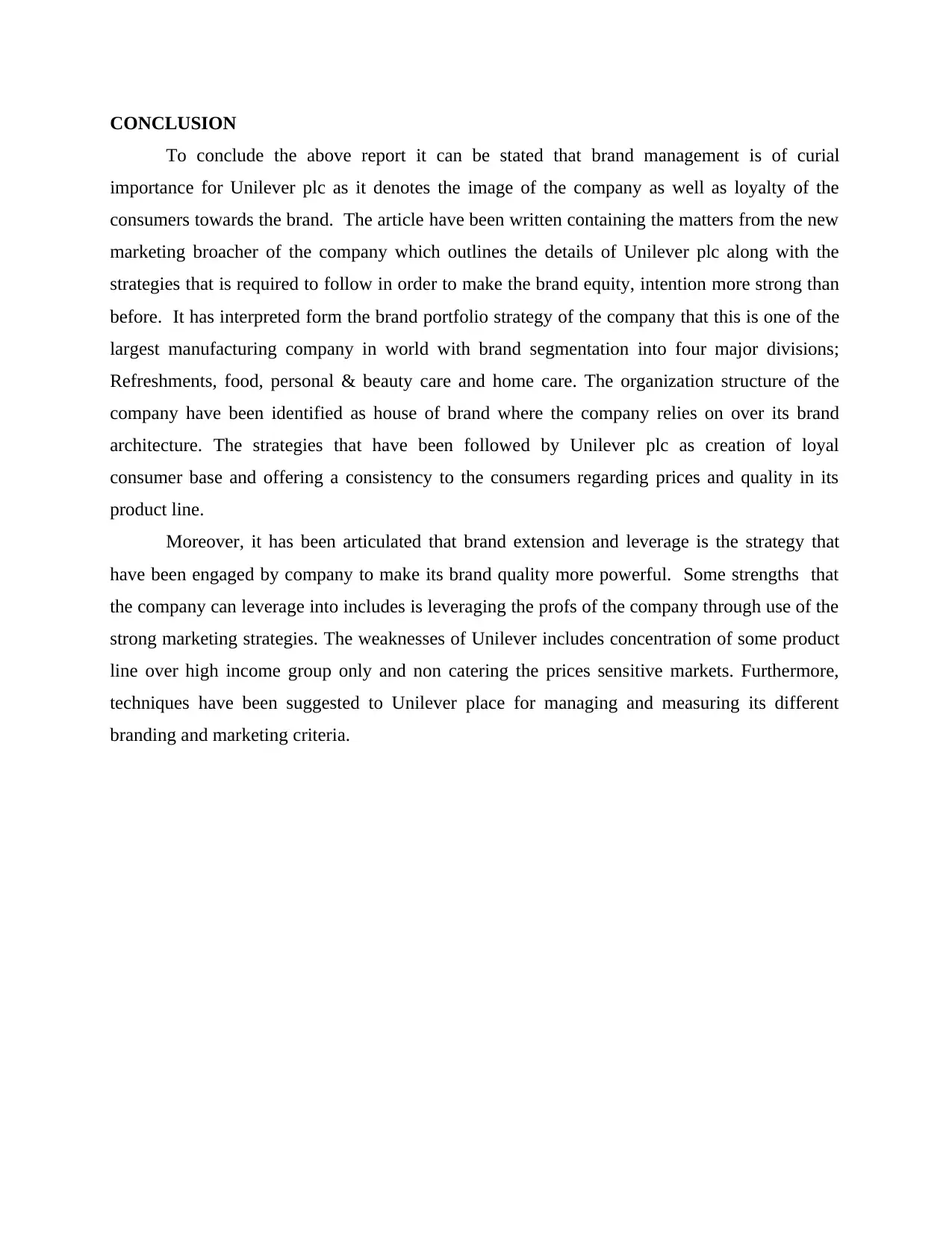
CONCLUSION
To conclude the above report it can be stated that brand management is of curial
importance for Unilever plc as it denotes the image of the company as well as loyalty of the
consumers towards the brand. The article have been written containing the matters from the new
marketing broacher of the company which outlines the details of Unilever plc along with the
strategies that is required to follow in order to make the brand equity, intention more strong than
before. It has interpreted form the brand portfolio strategy of the company that this is one of the
largest manufacturing company in world with brand segmentation into four major divisions;
Refreshments, food, personal & beauty care and home care. The organization structure of the
company have been identified as house of brand where the company relies on over its brand
architecture. The strategies that have been followed by Unilever plc as creation of loyal
consumer base and offering a consistency to the consumers regarding prices and quality in its
product line.
Moreover, it has been articulated that brand extension and leverage is the strategy that
have been engaged by company to make its brand quality more powerful. Some strengths that
the company can leverage into includes is leveraging the profs of the company through use of the
strong marketing strategies. The weaknesses of Unilever includes concentration of some product
line over high income group only and non catering the prices sensitive markets. Furthermore,
techniques have been suggested to Unilever place for managing and measuring its different
branding and marketing criteria.
To conclude the above report it can be stated that brand management is of curial
importance for Unilever plc as it denotes the image of the company as well as loyalty of the
consumers towards the brand. The article have been written containing the matters from the new
marketing broacher of the company which outlines the details of Unilever plc along with the
strategies that is required to follow in order to make the brand equity, intention more strong than
before. It has interpreted form the brand portfolio strategy of the company that this is one of the
largest manufacturing company in world with brand segmentation into four major divisions;
Refreshments, food, personal & beauty care and home care. The organization structure of the
company have been identified as house of brand where the company relies on over its brand
architecture. The strategies that have been followed by Unilever plc as creation of loyal
consumer base and offering a consistency to the consumers regarding prices and quality in its
product line.
Moreover, it has been articulated that brand extension and leverage is the strategy that
have been engaged by company to make its brand quality more powerful. Some strengths that
the company can leverage into includes is leveraging the profs of the company through use of the
strong marketing strategies. The weaknesses of Unilever includes concentration of some product
line over high income group only and non catering the prices sensitive markets. Furthermore,
techniques have been suggested to Unilever place for managing and measuring its different
branding and marketing criteria.
Secure Best Marks with AI Grader
Need help grading? Try our AI Grader for instant feedback on your assignments.
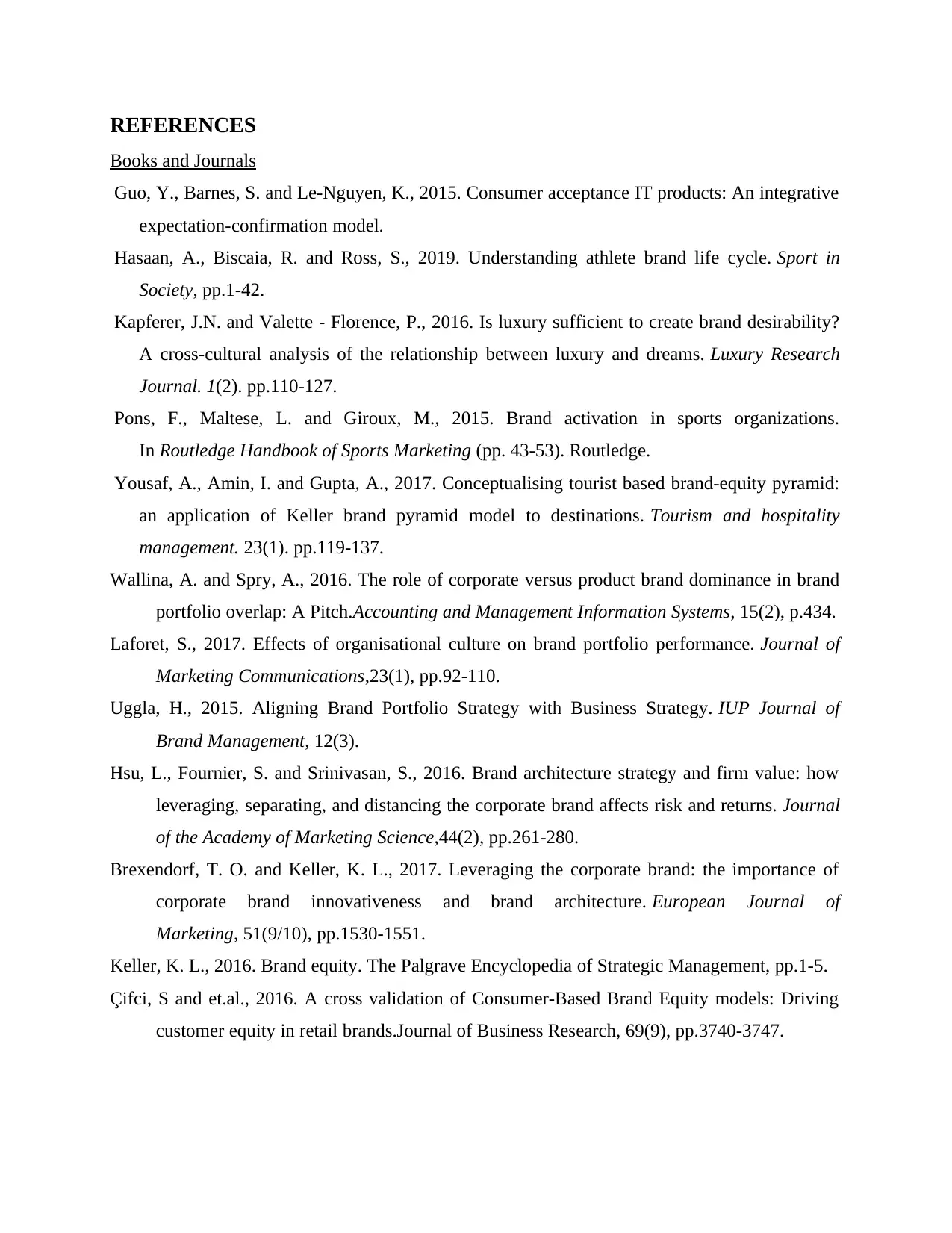
REFERENCES
Books and Journals
Guo, Y., Barnes, S. and Le-Nguyen, K., 2015. Consumer acceptance IT products: An integrative
expectation-confirmation model.
Hasaan, A., Biscaia, R. and Ross, S., 2019. Understanding athlete brand life cycle. Sport in
Society, pp.1-42.
Kapferer, J.N. and Valette - Florence, P., 2016. Is luxury sufficient to create brand desirability?
A cross-cultural analysis of the relationship between luxury and dreams. Luxury Research
Journal. 1(2). pp.110-127.
Pons, F., Maltese, L. and Giroux, M., 2015. Brand activation in sports organizations.
In Routledge Handbook of Sports Marketing (pp. 43-53). Routledge.
Yousaf, A., Amin, I. and Gupta, A., 2017. Conceptualising tourist based brand-equity pyramid:
an application of Keller brand pyramid model to destinations. Tourism and hospitality
management. 23(1). pp.119-137.
Wallina, A. and Spry, A., 2016. The role of corporate versus product brand dominance in brand
portfolio overlap: A Pitch.Accounting and Management Information Systems, 15(2), p.434.
Laforet, S., 2017. Effects of organisational culture on brand portfolio performance. Journal of
Marketing Communications,23(1), pp.92-110.
Uggla, H., 2015. Aligning Brand Portfolio Strategy with Business Strategy. IUP Journal of
Brand Management, 12(3).
Hsu, L., Fournier, S. and Srinivasan, S., 2016. Brand architecture strategy and firm value: how
leveraging, separating, and distancing the corporate brand affects risk and returns. Journal
of the Academy of Marketing Science,44(2), pp.261-280.
Brexendorf, T. O. and Keller, K. L., 2017. Leveraging the corporate brand: the importance of
corporate brand innovativeness and brand architecture. European Journal of
Marketing, 51(9/10), pp.1530-1551.
Keller, K. L., 2016. Brand equity. The Palgrave Encyclopedia of Strategic Management, pp.1-5.
Çifci, S and et.al., 2016. A cross validation of Consumer-Based Brand Equity models: Driving
customer equity in retail brands.Journal of Business Research, 69(9), pp.3740-3747.
Books and Journals
Guo, Y., Barnes, S. and Le-Nguyen, K., 2015. Consumer acceptance IT products: An integrative
expectation-confirmation model.
Hasaan, A., Biscaia, R. and Ross, S., 2019. Understanding athlete brand life cycle. Sport in
Society, pp.1-42.
Kapferer, J.N. and Valette - Florence, P., 2016. Is luxury sufficient to create brand desirability?
A cross-cultural analysis of the relationship between luxury and dreams. Luxury Research
Journal. 1(2). pp.110-127.
Pons, F., Maltese, L. and Giroux, M., 2015. Brand activation in sports organizations.
In Routledge Handbook of Sports Marketing (pp. 43-53). Routledge.
Yousaf, A., Amin, I. and Gupta, A., 2017. Conceptualising tourist based brand-equity pyramid:
an application of Keller brand pyramid model to destinations. Tourism and hospitality
management. 23(1). pp.119-137.
Wallina, A. and Spry, A., 2016. The role of corporate versus product brand dominance in brand
portfolio overlap: A Pitch.Accounting and Management Information Systems, 15(2), p.434.
Laforet, S., 2017. Effects of organisational culture on brand portfolio performance. Journal of
Marketing Communications,23(1), pp.92-110.
Uggla, H., 2015. Aligning Brand Portfolio Strategy with Business Strategy. IUP Journal of
Brand Management, 12(3).
Hsu, L., Fournier, S. and Srinivasan, S., 2016. Brand architecture strategy and firm value: how
leveraging, separating, and distancing the corporate brand affects risk and returns. Journal
of the Academy of Marketing Science,44(2), pp.261-280.
Brexendorf, T. O. and Keller, K. L., 2017. Leveraging the corporate brand: the importance of
corporate brand innovativeness and brand architecture. European Journal of
Marketing, 51(9/10), pp.1530-1551.
Keller, K. L., 2016. Brand equity. The Palgrave Encyclopedia of Strategic Management, pp.1-5.
Çifci, S and et.al., 2016. A cross validation of Consumer-Based Brand Equity models: Driving
customer equity in retail brands.Journal of Business Research, 69(9), pp.3740-3747.
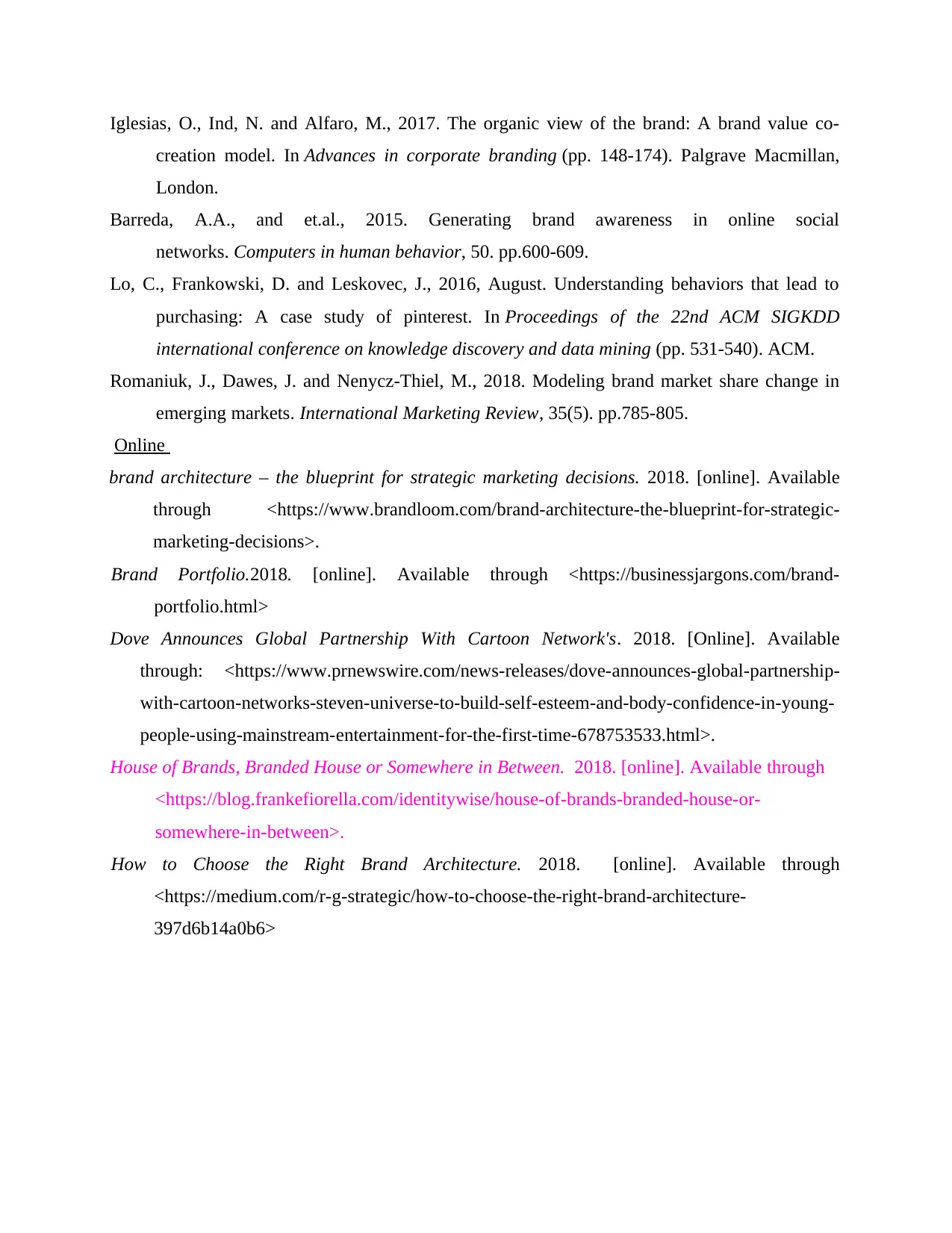
Iglesias, O., Ind, N. and Alfaro, M., 2017. The organic view of the brand: A brand value co-
creation model. In Advances in corporate branding (pp. 148-174). Palgrave Macmillan,
London.
Barreda, A.A., and et.al., 2015. Generating brand awareness in online social
networks. Computers in human behavior, 50. pp.600-609.
Lo, C., Frankowski, D. and Leskovec, J., 2016, August. Understanding behaviors that lead to
purchasing: A case study of pinterest. In Proceedings of the 22nd ACM SIGKDD
international conference on knowledge discovery and data mining (pp. 531-540). ACM.
Romaniuk, J., Dawes, J. and Nenycz-Thiel, M., 2018. Modeling brand market share change in
emerging markets. International Marketing Review, 35(5). pp.785-805.
Online
brand architecture – the blueprint for strategic marketing decisions. 2018. [online]. Available
through <https://www.brandloom.com/brand-architecture-the-blueprint-for-strategic-
marketing-decisions>.
Brand Portfolio.2018. [online]. Available through <https://businessjargons.com/brand-
portfolio.html>
Dove Announces Global Partnership With Cartoon Network's. 2018. [Online]. Available
through: <https://www.prnewswire.com/news-releases/dove-announces-global-partnership-
with-cartoon-networks-steven-universe-to-build-self-esteem-and-body-confidence-in-young-
people-using-mainstream-entertainment-for-the-first-time-678753533.html>.
House of Brands, Branded House or Somewhere in Between. 2018. [online]. Available through
<https://blog.frankefiorella.com/identitywise/house-of-brands-branded-house-or-
somewhere-in-between>.
How to Choose the Right Brand Architecture. 2018. [online]. Available through
<https://medium.com/r-g-strategic/how-to-choose-the-right-brand-architecture-
397d6b14a0b6>
creation model. In Advances in corporate branding (pp. 148-174). Palgrave Macmillan,
London.
Barreda, A.A., and et.al., 2015. Generating brand awareness in online social
networks. Computers in human behavior, 50. pp.600-609.
Lo, C., Frankowski, D. and Leskovec, J., 2016, August. Understanding behaviors that lead to
purchasing: A case study of pinterest. In Proceedings of the 22nd ACM SIGKDD
international conference on knowledge discovery and data mining (pp. 531-540). ACM.
Romaniuk, J., Dawes, J. and Nenycz-Thiel, M., 2018. Modeling brand market share change in
emerging markets. International Marketing Review, 35(5). pp.785-805.
Online
brand architecture – the blueprint for strategic marketing decisions. 2018. [online]. Available
through <https://www.brandloom.com/brand-architecture-the-blueprint-for-strategic-
marketing-decisions>.
Brand Portfolio.2018. [online]. Available through <https://businessjargons.com/brand-
portfolio.html>
Dove Announces Global Partnership With Cartoon Network's. 2018. [Online]. Available
through: <https://www.prnewswire.com/news-releases/dove-announces-global-partnership-
with-cartoon-networks-steven-universe-to-build-self-esteem-and-body-confidence-in-young-
people-using-mainstream-entertainment-for-the-first-time-678753533.html>.
House of Brands, Branded House or Somewhere in Between. 2018. [online]. Available through
<https://blog.frankefiorella.com/identitywise/house-of-brands-branded-house-or-
somewhere-in-between>.
How to Choose the Right Brand Architecture. 2018. [online]. Available through
<https://medium.com/r-g-strategic/how-to-choose-the-right-brand-architecture-
397d6b14a0b6>
1 out of 18
Related Documents
Your All-in-One AI-Powered Toolkit for Academic Success.
+13062052269
info@desklib.com
Available 24*7 on WhatsApp / Email
![[object Object]](/_next/static/media/star-bottom.7253800d.svg)
Unlock your academic potential
© 2024 | Zucol Services PVT LTD | All rights reserved.





